|
|
|
|
|

|
36 pages. This annotated narrative is based on extant Tanuki art (175 photos herein). It describes, both chronologically and thematically, the metamorphosis of the spook-beast Tanuki from a bad guy to good guy, from feared to beloved. It also debunks widespread misinformation about Tanuki. It is intended as a "primer" for students and teachers of art history and folklore.
|
|
|
|
|
|
Tanuki, modern, ceramic. Sake Kai Tanuki 酒買狸 (lit. Tanuki Procuring Sake). Depicted with big tummy, staff, giant scrotum, straw hat, sake flask, and promissory note. Welcoming icon found frequently outside Japan’s bars and eateries (“come in, don’t be stingy”). Also a wealth-bringing icon adorning gardens.
Photo from Rakuten J-store
|
|
|
|
TANUKI MENU
|
|
|
|
Mythical versus Real Tanuki
Mistranslations, Confusing Names
Fox / Tanuki Lore in Old China
Fox / Tanuki Lore in Old Japan
17th Century Tanuki Art in Japan
18th Century Tanuki Art in Japan
19th Century Tanuki Art in Japan
20th Century Tanuki Art in Japan
|
|
|
|
TANUKI ATTRIBUTES
|
|
|
|
Tanuki’s Main Attributes
Big Belly & Belly Drumming
Origins of Big Belly & Drumming
Big Scrotum (aka Money Bags)
Leaf, Umbrella, Straw Hat
Sake Flask and Hachi (Eight)
Promissory Note It Never Pays
Under the Moon, Howling
Disguised as a Buddhist Monk
Tanuki Masks for Kyōgen Plays
Modern vs. Traditional Tanuki
|
|
|
|
TANUKI TALES, OTHERS
|
|
|
|
Bunbuku Chagama (Teapot) Tanuki
Kachi Kachi Yama & Rabbit
Danzaburō, Hage & Shibaemon
Heisei Tanuki Gassen Ponpoko
Shigaraki Ceramics & Tanuki
Badger Lore in China & Japan
Sources: Primary // Secondary // Misc.
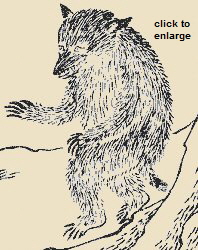
Tanuki standing on hind legs,
from the Kinmōzui 訓蒙圖彙 illustrated Japanese encyclopedia dated to 1666.
|
|
|
|
TANUKI’S NAMES & FORMS
|
|
|
|
Anaguma 穴熊 (badger)
Araiguma 洗熊 (racoon)
Bakedanuki 化け狸 (shape-shifter)
Bai 霾 (rain 雨 + Tanuki 貍)
Furudanuki 古狸 (old tanuki)
Iwadanuki 岩狸 (hyrax)
Kan 貛 (badger)
Kodanuki 小狸 (small tanuki)
Kokkuri 狐犬狸 (lit. fox, dog, tanuki)
Kori 狐狸 (lit. fox & tanuki)
Kōri 香狸 (civet)
Mameda 豆狸 (bean-loving tanuki)
Mamedanuki 豆狸 (small tanuki)
Mami 貒・猯 (tanuki or anaguma)
Midanuki 貒狸 (badger)
Mujina 貉・狢 (fox-like beast)
Ōkami 狼 (wolf)
Sai 豺 (mountain dog)
Tanuki 貍、狸、たぬき、タヌキ
Ya-byō, Ya-myō 野猫 (field cat)
Yūri 狖狸 (weasels & tanuki)
More Details Here
|
|

TANUKI 狸・貍, MUJINA 狢・貉, MAMI 猯・貒
Magical Fox-Like Dog with Shape-Shifting Powers
Trickster & Spook, Originally Evil, Now Benevolent
Modern-Day Icon of Generosity, Cheer, and Prosperity
Found Often Outside Japanese Bars & Restaurants
Most Images Can be Enlarged by Clicking
ORIGIN = Chinese Fox Lore + Japanese Accretions
Overview
The magical shape-shifting Tanuki is clearly a composite creature. The original evil parts come from old China and its fox lore (introduced to Japan between the 4th-7th centuries CE). The newer tamer parts, such as the big belly, belly drumming, giant scrotum, and sake bottle can be traced to late Edo-era Japan (18th-19th centuries), while the commercialized benevolent parts (promissory note, straw hat) emerged in Japanese artwork around the beginning of the 20th century. In general, the goofy-looking Tanuki we are familiar with today is a recent creation, mostly Japanese. But by carefully investigating Tanuki’s remote origins from China, we can demarcate original property from borrowed property. This endeavor, in my mind, leads to a greater appreciation of Japan’s penchant for creating imaginative, playful, and endearing myths. The Chinese influence on Japanese folklore, without doubt, is enormous. Yet the Japanese are equally adept at creating their own lore, as exemplified by their homespun Tanuki legends.
Mythical & Magical Tanuki
The fox-like Tanuki appear often in Japanese folklore as shape-shifters with supernatural powers and mischievous tendencies. In their earliest malevolent manifestations (transmitted via Chinese fox lore to Japan by at least the 7th century CE), Tanuki assumed human form, haunted and possessed people, and were considered omens of misfortune. Many centuries later in Japan, they evolved into irrepressible tricksters, aiming their illusory magic and mystifying belly-drum music at unwary travelers, hunters, woodsmen, and monks. Today, the Tanuki are cheerful, lovable, and benevolent rogues who bring prosperity and business success. For more on Tanuki’s metamorphosis from bad guy to good guy, see Tanuki Origins. Ceramic statues of Tanuki are found everywhere in modern Japan, especially outside bars and restaurants, where a pudgy Tanuki effigy typically beckons drinkers and diners to enter and spend generously (a role similar to Maneki Neko, the Beckoning Cat, who stands outside retail establishments.) In his modern form, the fun-loving Tanuki is commonly depicted with a big tummy, a straw hat, a bewildered facial expression (he is easily duped), a giant scrotum, a staff attached to a sake flask, and a promissory note (that he never pays). Many of these attributes suggest his money was wasted on wine, women, and food (but this is incorrect; see below). More surprisingly, most of these attributes were created in very modern times (in the last three centuries; see Tanuki in Modern Times). Although the Japanese continue to classify Tanuki as a yōkai 妖怪 (monster, spirit, specter, fantastic/strange being), the creature today is no longer frightening or mysterious. Instead, it has shape-changed into a harmless and amusing fellow, one more interested in encouraging generosity and cheerfulness among winers and diners than in annoying humankind with its tricks. Tanuki are also portrayed as cute and lovable characters in modern cartoons and movies -- even as mascots in commercial campaigns. For instance, the former Tokyo-Mitsubishi Bank not long ago used the Tanuki (and a Kappa river imp) to promote its DC credit card (a campaign since ended). These topics are explored below.
Real Life Tanuki
The Tanuki is also a real animal. It is often confused with the badger (ana-guma) and the raccoon (arai-guma). It is neither -- it is an atypical species of dog that can grow up to 60 cm. in length, with distinctive stripes of black fur under its eyes. In old Japan, Tanuki were hunted for their meat (reputed to have medicinal qualities), their fur (used for brushes and clothing) and their scrotal skin (used as a malleable sack for hammering gold into gold leaf). They live in burrows, and come out after sunset until the wee hours of the morning. Says the Yamasa Institute, Center for Japanese Studies Newsletter (Sept. 15, 2001): “As tanuki have moved into suburban and even urban areas in Japan during the 1980s and 1990s, they have taken to feeding at rubbish dumps and are even fed by local people in their gardens, which is one reason why they are associated with racoons who thrive on the rubbish littering many cities.....the future of the Tanuki [in Japan] is uncertain as many are afflicted with sarcoptic mange, a condition caused by a parasitic mite.” <end quote> Today (Oct. 16, 2011) I spoke with a representative of a cat-lovers group from Yokohama, one helping to find homes for stray cats, and she said many tanuki now inhabit the area, many steal the food set out for the cats, and many suffer from mange. To help the suffering tanuki, they inject a sweet bread with medicine (a bread the cats will not eat) and mix it together with food for the cats. This strategy has cured “a few tanuki” of mange. The Tanuki is reportedly native to Japan, southeastern Siberia, and Manchuria. Some were introduced to western parts of the Soviet Union for fur farming in the 1950s, and have since spread into Scandinavia and as far south as France. Scientific Name: Canis Procyonoides, Canis Viverrinus, Nyctereutes Procyonoides. Belongs to dog family. Canini (related to wolves) and Vulpini (related to foxes). See Tanuki Fact Sheet.
Mistranslations of Tanuki
Confused Naming Conventions
Neither the badger nor the racoon (raccoon) figure prominently in Chinese or Japanese folklore or artwork. Nonetheless, for decades, Western scholars have mistranslated Tanuki as “badger” or “racoon-dog.” This is clearly wrong, but can be forgiven -- the Tanuki does, in fact, look badger-like, racoon-like, and fox-like. Furthermore, such mistranslations are compounded by the Japanese themselves, who have likewise confused these animals in their folklore and artwork. For all practical purposes, the moniker “TANUKI” includes other similar creatures like the badger, racoon, the mujina 貉 and mami 貒 (other names for Tanuki in some Japanese localities), wild mountain dogs and cats, and most other fox-like creatures. This confusion is sometimes the source of great amusement. In Tochigi Prefecture, for example, the Tanuki is called “Mujina.” In 1924, in the so-called Tanuki-Mujina Incident たぬき・むじな事件, Tochigi authorities prohibited the hunting of Tanuki and promptly arrested one hunter -- who claimed he was out hunting mujina. The man was taken to trial, but eventually acquitted (on 9 June 1925). His defense argued that hunting of “mujina” was not prohibited by law, that the hunter’s intention was to pursue mujina, and therefore, by law, he was not guilty of any offense. In Japan’s northern Kanto region, Tanuki is known as MUJINA. In the Tokyo area, the creature is called MAMI. In the Kinki region (around Osaka), the beast is referred to as TANUKI. <Source: National Institute of Japanese Literature, Mitsuru Aida>
  
PHOTOS LEFT TO RIGHT. (1) Real Tanuki in garden of Gabi Greve (Japan); (2) Real Baby Tanuki, photo Adam Nuelken;
(3) Mammalian Species, Tanuki Fact Sheet, by the American Society of Mammalogists #358 (1987-1991)

|
ORIGIN = Fox and Tanuki Lore in Old China
|
|
Japan’s Tanuki lore clearly sprang from the same page as China’s earlier fox mythology (see Table 1). Fox lore in China is ancient and voluminous, while Tanuki lore is almost non-existent. China’s vulpine lore is also complex. The ill-boding evil fox is mentioned early on by the Chinese sage Zhuāngzí / Chuang-tzu 莊子 (369-286 BC; Jp. = Sōshi). [need citation] Chinese texts from the 3rd century AD onward speak frequently of foxes as spook-beasts causing insanity, disease, and death, of possessing and bewitching both men and women, of hypnotizing people and leading them into perilous situations, and of shape-shifting into human form (typically a were-vixen) to carry out their unprovoked malignity. Foxes grow in power as they age. They grow a tail for each century of life. When they reach 900 years of age, a nine-tailed fox 九尾狐 gains the power of infinite vision (in some texts, the creature is a good omen, in others a bad omen). Foxes who live to be 1,000 years or older are called Celestial Foxes 天狐 and no longer haunt mankind. The shape-shifting power of the fox is not perfect. While transformed, the fox is susceptible to the same pressures and natural predators faced by the form it assumes. Foxes were much persecuted in old China, mostly by smoking them out of their burrows (often located in caved-out old graveyards). This prompted Chinese authorities to forbid smoking foxes out of graveyards. Similar laws were later enacted in Japan during the reign of Emperor Mommu 文武 (697-707). Promulgated in 702 in Section VII of the Zokutō Ritsu 賊盗律 (Laws Concerning Robbers), these edicts warned against "smoking foxes and tanuki (Jp. = Kori 狐狸) out of graves.” The term Kori 狐狸 comes from earlier Chinese texts, in which the characters for fox 狐 and tanuki 狸 were combined 狐狸. However, in China, the combined term means “foxes” only. Early references to 狐狸 are found in the Sōushénjì 搜神記 (Sheu Shen Ki), a 4th-century Chinese document attributed to Gan Bao 干寶 (fl. 317-322). This usage (limited to the fox) is substantiated by the near-absence of Tanuki lore in China. <sources: De Groot, p191 & De Visser, p1>
|
|
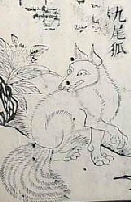
From China’s 1610 Sansai-zue
illustrated encyclopedia.
PHOTO: this J-Site
|

From Japan’s 1666
Kinmōzui illustrated encyclopedia. PHOTO: this J-site
|
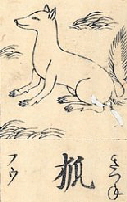
From Japan’s 1715 illustrated
Wakan Sansai-zue encyclopedia.
PHOTO: this J-site.
|
|
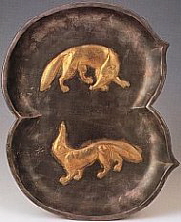
|
Photos at left and right
Parcel-gilt silver dish with animal design. D = 22.5 cm, H = 1.5 cm. 8th century, China. Shaanxi Historical Museum. Photo from exhibition catalog (p. 219) entitled Treasures of Ancient China, Oct. 24 - Dec. 17, 2000, Tokyo Nat’l Museum, Published by Asahi Shimbun. The catalog notes the “fox-like” features, but says the head and ears differ from those of real foxes. Perhaps this is an early Chinese example of the magical fox-like Hó 貉 (Jpn. = Mujina). See below for 17-century Japanese depiction of a Mujina.
|

|
|
|
|
|
|
|
|
|
TABLE 1 - Comparing Fox-Tanuki Lore in China & Japan
The Chinese fox predates the Japanese Tanuki by many centuries. Japan’s Tanuki
clearly derives from the same page as China’s fox. Below items listed in no particular order.
|
|
 = Yes, = Yes,  = No = No
|
China
Fox
|
Japan
Fox
|
Japan
Tanuki / Mujina
|
NOTES
|
|
can possess people
|

|

|

|
Fox possession (kitsune tsuki 狐憑き); fox bewitchment (kitsune damashi 狐だまし
|
|
haunts houses, locations
|

|

|

|
live in caved-out graveyard plots and burrows
|
|
can shift into male, female,
inanimate forms (Buddha, Bosatsu, monk, nun, teapot)
|

|

|

|
fox / tanuki normally shift into female form,
but tanuki are less adept and instead often shift
into inanimate shapes, like a tea pot
|
|
often assumes form
of beautiful woman
|

|

|

|
their evil nature represents YIN; therefore they
shape-shift into forms to atttract YANG (male)
|
|
gains power as it ages
|

|

|

|
the older, the more powerful
|
|
both good and bad
|

|

|

|
mostly evil in China, albeit a few exceptions
|
|
dogs are mortal enemies
|

|

|

|
common dogs can kill fox, mujina, and tanuki
|
|
holds / possesses jewel
|

|

|

|
in the Japanese Nihongi, mujina has jewel in belly
|
|
needs object to transform
|

|

|

|
fox = human skull & bones; tanuki = leaves
|
|
nocturnal
|

|

|

|
moon is a common theme in tanuki artwork
|
|
howling is bad omen
|

|

|

|
in a few cases, howling is considered good
|
|
turns pebbles into gold
turns dung into food
|

|

|

|
both the fox & tanuki can cast powerful illusions
and create mirages of markets, cities, & palaces
|
|
sees future, its own death
|

|

|

|
can portend future events, both human & spirit world
|
|
eating its flesh cures
ulcers and other problems
|

|

|

|
fox = flesh cures ulcers, liver revives the dead, blood refreshes the drunk; tanuki meat cures piles & ulcers
|
|
gains tail as it ages
|

|

|

|
fox gains a tail for every 100 years of age
nine-tail fox is all powerful and a good omen
|
|
divine connection
|

|

|

|
in Japan, the fox is a messenger of Inari (rice kami)
|
|
can breed with humans
|

|

|

|
in Japan, Tanuki have fewer powers than foxes
|
|
can conjure fire & lights (infitur ignitus)
|

|

|

|
will-o’-the-wisps; fox fire (Kitsune-bi), tanuki fire (Tanubi-bi), perhaps due to their eyes shining in dark
|
|
SOURCES: Numerous Chinese and Japanese documents (see Resources), extant Japanese artwork (as appearing within this story), and English resources such as De Visser (1908) // Violet H. Harada (1976) // U.A. Casal (1959).
|
|

|

|

|

|

|
|
 |
|
|
|
|
|
Fox and Tanuki Lore in Old Japan
|
|
|
|
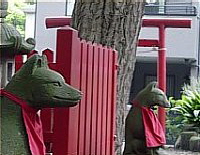
Two fox guardians at Inari Shrine
just outside Tsurugaoka Hachimangū Shrine in Kamakura.
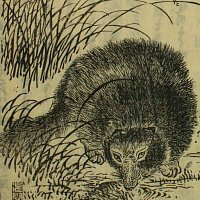
Tanuki, Kyokutei Bakin’s 曲亭馬琴
(1767-1848) Enseki Zasshi 燕石雑志.
Digital version at Waseda Library.
Jump directly to digitized photo.
Jump directly to Tanuke 田之怪 text.
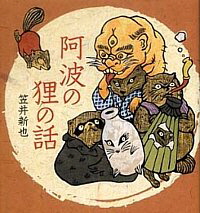
Book cover. Stories of Tanuki in Awa Province (Awa no Tanuki no Hanashi 阿波の狸の話), by Kasai Shin'ya 笠井新也. First published in 1927 (Chūkōbunko 中公文庫). Modern-day reprints available at Kinokuniya Bookweb. Among the various images of Tanuki on this book cover, we see the one-eyed Tanuki who can produce thunder.
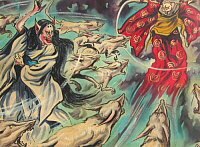
Flying-Dragon Tanuki 飛龍狸 (in red robe) Battles 9-Tailed White Fox 白九尾の狐. From a mid- 20th-century Kami Shibai 紙芝居 (Paper Theatre Drawing). Photo Tokyo Metropolitan Library. For more details about this drawing, see below.

Fox (or a Tanuki or Mujina?).
Holding jewel. Unsigned ivory netsuke. Early 19th century. H = 6.5 cm.
Its bulging stomach suggests
a Tanuki / Mujina. Photo from
Scholten Japanese Art
|
|
|
 As Table 1 above shows, Japan’s tanuki lore was derived predominantly from China’s fox lore, although the Japanese did add a “divine” connection between their fox and their local kami (deity) of rice, Inari. This gives the fox a dual character in Japan -- both evil and sacred. This dichotomy is not found in China, where the fox is mostly evil. Second, in Japan, Tanuki are portrayed as less adroit, less clever, and less dignified than foxes, no doubt reflecting the fox’s divine association with Inari (from around the 11th century onward, Inari was portrayed alongside white foxes or atop a white fox). Unlike the fox, the Tanuki was also given a humorous side -- he often appears as a clever schemer, but is easily outwitted and duped. Third, Tanuki were not even mentioned in Japan’s earliest documents (8th century) -- they appear much later, in the 13th-century Uji Shūi Monogatari 宇治拾遺物語 (where a tanuki shape-changes into Fugen Bosatsu but is eventually discovered and killed) and the 14th-century Nichū Reki 二中暦 (a Japanese zodiac calendar wherein the tanuki, mujna, and fox are listed among the 36 animals of Zodiac Calendar (Chikusan Reiki 畜産暦). In fact, it is the fox-like Mujina (conflated with Tanuki) who comes first to Japan. Unlike foxes, who appear often in Japanese texts from the 8th century forward, the mujina are only mentioned twice in the Nihon Shoki 日本書紀 (Japan’s oldest text, also known as the Nihongi or Chronicles of Japan, circa 720 AD). Moreover, for reasons unknown, the mujina disappear from Japanese literature after the 8th century and do not reappear until the 18th, when they are conflated with (by then) the popular Tanuki. As Table 1 above shows, Japan’s tanuki lore was derived predominantly from China’s fox lore, although the Japanese did add a “divine” connection between their fox and their local kami (deity) of rice, Inari. This gives the fox a dual character in Japan -- both evil and sacred. This dichotomy is not found in China, where the fox is mostly evil. Second, in Japan, Tanuki are portrayed as less adroit, less clever, and less dignified than foxes, no doubt reflecting the fox’s divine association with Inari (from around the 11th century onward, Inari was portrayed alongside white foxes or atop a white fox). Unlike the fox, the Tanuki was also given a humorous side -- he often appears as a clever schemer, but is easily outwitted and duped. Third, Tanuki were not even mentioned in Japan’s earliest documents (8th century) -- they appear much later, in the 13th-century Uji Shūi Monogatari 宇治拾遺物語 (where a tanuki shape-changes into Fugen Bosatsu but is eventually discovered and killed) and the 14th-century Nichū Reki 二中暦 (a Japanese zodiac calendar wherein the tanuki, mujna, and fox are listed among the 36 animals of Zodiac Calendar (Chikusan Reiki 畜産暦). In fact, it is the fox-like Mujina (conflated with Tanuki) who comes first to Japan. Unlike foxes, who appear often in Japanese texts from the 8th century forward, the mujina are only mentioned twice in the Nihon Shoki 日本書紀 (Japan’s oldest text, also known as the Nihongi or Chronicles of Japan, circa 720 AD). Moreover, for reasons unknown, the mujina disappear from Japanese literature after the 8th century and do not reappear until the 18th, when they are conflated with (by then) the popular Tanuki.
The fox’s divine connection to Inari (Japan’s god of rice) is hard to discern, but the most accepted theory today involves Japan‘s Yama-no-Kami 山の神 (mountain deity) and Ta-no-Kami 田の神 (rice-paddy deity). In Japanese folklore, the mountain kami was believed to descend from its mountain residence in the winter to become the rice-paddy kami in the spring, residing there throughout the growing season. After the fall harvest, the deity returned once again to its winter home in the mountains. All this probably took place at the same time that foxes appeared each season. As such, the fox naturally became known as the messenger of Inari. <See Kokugakuin University’s Encyclopedia of Shinto for details.> Interestingly, scholar Kyokutei Bakin 曲亭馬琴 (1767-1848) suggests the term “Tanuki” was derived from Ta-no-Ke 田之怪 (rice-field spook) or from Ta-Neko 田猫 (rice-field cat), and says the Japanese sometimes refer to Tanuki as Ya-byō or Ya-myō 野猫 (field cat), and to cats as Ka-ri 家狸 (house tanuki). <see Bakin’s Enseki Zasshi 燕石雑志, Chapter 5, Tanuke 田之怪 section or photo, Waseda University Library> Art historian Katherine M. Ball (1859-1952) says tanuki were known commonly in China as Yě Māo 野猫 (wild cat; cross between foxes and cats), but she provides no reference (p. 141). In Japan’s Osaka-Kyoto-Kobe sake brewing area, the Tanuki is also popularly known as mameda 豆狸 (small tanuki, lit. “bean tanuki”), for he likes to stuff himself on beans (mame 豆) and to steal sake on rainy nights. If we employ Bakin’s rational, we could easily replace the da 狸 of mameda with ta 田 (field), which would yield 豆田, or bean field, again connecting Tanuki with cultivation & food.
Tanuki remain relatively unknown in Japan until the late 16th and early 17th centuries, after which they appear in countless Edo-era stories (see Tanuki Tales from Japan below; also see De Visser). These tricksters can transform into any living or inanimate shape. Real Tanuki live in the lowlands, forests, and mountain valleys, and therefore Tanuki are most often shown playing tricks on hunters and woodsmen. But they also enjoy misleading learned scholars, and therefore shape-shift into Buddhist monks (as do foxes) with a deep knowledge of the sutras. They can cast powerful illusions (like foxes), turn pebbles and leaves into fake money or dung into a delicious-looking dinner, conjure up mirages of entire cities and palaces, appear as one-eyed demons able to produce thunder and rain, rob the bodies of the dead, and cause pebbles to rain from the sky. In some tales, they are even gifted calligraphers. The Tanuki of Japan are also lovers of Japanese sake (rice wine), and in artwork are depicted commonly with a sake flask in one hand and a promissory note in the other (a bill it never pays). These latter attributes are purely Japanese (see Table 2) with no connection to Chinese fox lore. The underlying link to China’s fox, however, has not been forgotten. In the 1994 hit movie Heisei Tanuki, a Tanuki changes into a white fox and scares the wits out of the people who want to move a Shinto shrine to develop the land.
SPECULATION. Why did Tanuki become popular in the Edo Period? From the 13th through 15th centuries, the orthodox Buddhist sects (Shingon and Tendai plus the Six Schools of Nara) competed fiercely for followers, not only among themselves, but against the newly formed and thriving schools of the Kamakura reformation (Pure Land, Zen, and Nichiren) -- the latter stressed pure and simple faith over complicated rites and doctrines and deplored the perfumed embroidery of the court and the intellectual elitism of the entrenched monasteries. Amidst this volatile scene, Japan's orthodox sects probably employed Buddhist deities, local kami, and yōkai 妖怪 (fantastic creatures like the Tanuki) in new formats to attract and maintain their followers. The Seven Lucky Gods of Japan, for example, appeared between the 15th and 17th centuries.
|
|
|
|
|
|
 |
|
|
|
|
|
|
17th Century Tanuki & Mujina Artwork
|
|
Tanuki artwork did not figure prominently in Japan’s visual culture before the 17th century. As far as I know, the below images are the oldest extant representations of the creature. One comes from the Sansai-zue 三才圖會 (Chn. = Sāncáitúhuì, San Ts'ai T'u Hui, by Wang Qi 王圻), lit. Illustrated Compendium of Heaven, Earth, and Humanity, a Chinese document dated to 1610. Two others come from the Kinmōzui 訓蒙図彙 or 訓蒙圖彙 (Collected Illustrations to Instruct the Unenlightened), a 20-volume Japanese work compiled in 1666 by Nakamura Tekisai 中村惕斎 (1629-1702) and considered Japan's first illustrated encyclopedia. The Kinmōzui went through numerous editions (see digitized 1789 version at the Kyūshū University Museum Digital Archive) and sparked the creation of many other similar works. It drew its inspiration from the earlier Sansai-zue from China. Two points worthy of mention: (1) the Kinmōzui says nothing about Tanuki’s supernatural powers; (2) Tanuki is grouped together with creatures it physically resembles, like the fox, wolf, and badger. <see Michael D. Foster (2008), pp 35-42>
|
|
click to enlarge
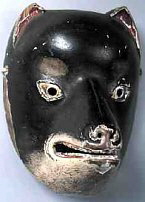
|
click to enlarge
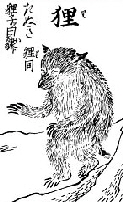
|
click to enlarge
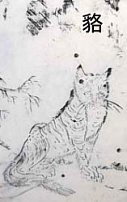
|
click to enlarge
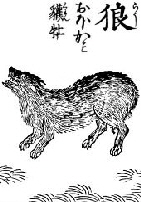
|
|
Tanuki Mask
Kyōgenmen 狂言面 (masks for Kyōgen plays). 16-17th century.
See Tanuki Masks below.
PHOTO: Wakayama Museum
|
Tanuki 狸
Chn. = Lí
Fox-like Animal
From 1666 Kinmōzui.
PHOTO: this J-site
|
Mujina 貉 or 狢
Chn. = Hó or Háo
Conflated with Tanuki.
From 1610 Sansai-zue
PHOTO: this J-Site.
|
Wolf 狼 or Badger 貛
Wolf C = Láng, J = Rō
Badger C = Huān, J = Kan
Conflated with Tanuki.
PHOTO: 1666 Kinmōzui
|
|
NOTE: Fox-like, Tanuki-like creatures appear in the 12th-century comical and satirical hand scroll known as Frolicking Animals and Humans (Chōjū Jinbutsu Giga 鳥獣人物戯画), a national treasure owned by Kōzan-ji Temple 高山寺 in Kyoto. These creatures are most probably FOXES -- the Tanuki, if we recall, does not make an appearance in written Japanese texts until the 13th century. Similar creatures may appear in 16th-17th century works such as the comical Hyakkiyagyō Emaki 百鬼夜行絵巻, the Bakemono Zukushi 化け物ずくし (Complete Bakemono; artist unknown), and the 1737 Hyakkai Zukan 百怪図巻 (Illustrated Scroll of a Hundred Mysteries) by Sawaki Sūshi 佐脇嵩之 (1707-1772). But I did not have the opportunity to review these documents and therefore they are not discussed herein. If they contain Tanuki artwork, please contact me.
|
|
|
|
|
|
|
 |
|
|
|
|
|
|
18th Century Tanuki, Mujina, Mami, & Fox Artwork
|
|
The below drawings come from the Wakan Sansai-zue 和漢三才図会, a Japanese encyclopedia completed around 1715 AD. One shows Tanuki standing on his hind legs, but all the others are based largely on the real-world appearance of the animals. Two points are worthy of mention: (1) Like the earlier Kinmōzui, the Wakan Sansai-zue says little about Tanuki’s magical powers, except “like a kitsune (fox), an old tanuki will often transform into a yōkai;” (2) Tanuki is still grouped together with creatures it physically resembles, like the fox, wolf, and badger. <see Foster (2008) for details, pp 35-42> Also, this encyclopedia says eating Tanuki flesh in the form of soup cures piles and running ulcers. <see De Visser, p. 102> Even today, people eat a soup called Tanuki Jiru 狸汁.
|
|
 click to enlarge click to enlarge
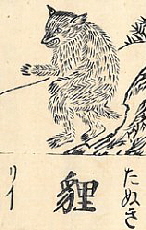
|
 click to enlarge click to enlarge
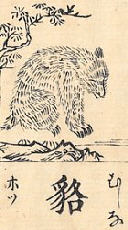
|
 click to enlarge click to enlarge
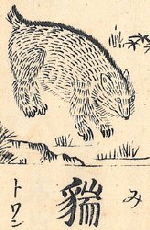
|
 click to enlarge click to enlarge
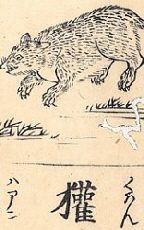
|
|
Tanuki 狸
Chn. = Lí
Fox-like Animal
Photo Vol. 38
|
Mujina 貉 or 狢
Chn. = Hó or Háo
Fox-like Animal, Nocturnal
Photo Vol. 38
|
Mami 貒 or 猯
Chn. = Tuān
Fox-like, Badger-like
Photo Vol. 38
|
Kan / Ken / Gen 貛
Chn. = Huān
Mami-like BADGER
Photo Vol. 38
|
|
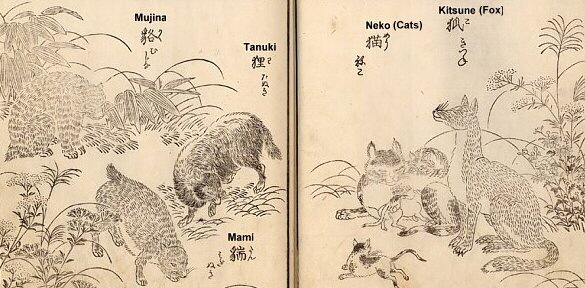
Tanuki 狸 (C = Lí), Mujina 貉 or 狢 (C = Hó, Háo), Mami 貒 (C = Tuān), Kitsune (C = Hú), Cats 猫 or 貓 (C = Māo)
From the 1789 Japanese document Kashiragakizōho Kinmōzui Taisei 頭書増補訓蒙圖彙大成.
These animals appear on adjoining pages -- suggesting perhaps some interrelation, not just similar physical traits.
Photo Source: Kyūshū University Museum Digital Archive.
|
|
NOTE: The Wakan Sansai-zue 和漢三才図会 (Illustrated Japan-China Compendium of Heaven, Earth, and Humanity, aka Collected Japanese-Chinese Illustrations of the Three Realms) is a 105-volume Japanese encyclopedia released around 1715 AD, attributed to Osaka-based medical practitioner Terajima Ryōan 寺島良安, and republished numerous times. This important work has been digitally scanned by various organizations (Kyūshū University Museum Digital Archive, Wakan Entrance || V 38; as well as the National Diet Library, V 1-36 || V 37-71 || V 72-105). The Tanuki image above is a near-exact copy of one appearing in the earlier 1666 Kinmōzui 訓蒙図彙. Both documents were created in the same spirit as the 1610 Chinese work Sansai-zue 三才圖會.
|
|
|
|
|
|
|
 |
|
|
|
|
Late 18th Century Tanuki, Mujina, Fox, & Similar Creatures
|
|
The below drawings come from the Zōho Shoshū Butsuzō-zui 増補諸宗仏像図彙 (1783), the enlarged version of an earlier text (1690) known as the Butsuzō zui 仏像図彙 (Illustrated Compendium of Buddhist Images). Both are monumental dictionaries of Buddhist iconography and contain hundreds of black-and-white drawings. Here we present eight drawings from a Zodiac grouping known as the Thirty-six Calendar Animals (Sanjūroku Kingyōzō 三十六禽形像; alternatively known as the Chikusan Reiki 畜産暦). The group originated in China, wherein the 36 were divided into four clusters, with each cluster made up of nine animal-deity pairs (4 X 9 = 36). The four clusters represent the four cardinal directions (north, south, east, west). The animals are also grouped in triads -- three animals are combined under one of 12 Zodiac Signs (3 X 12 = 36). In Japan, the group appeared in the Nichū Reki 二中暦, a Japanese calendar from the second half of the 14th century. Curiously, eight of the 36 appear “fox like” -- almost identical in physical attributes. These eight (presented below) include the tanuki, mujna, fox, wolf, jackal, wild cat, and wild male-female dogs. The mujina, fox and rabbit are combined under the zodiacal sign of the rabbit. The tanuki, leopard, and tiger are combined under the zodiacal sign of the tiger. Western scholars have mistranslated tanuki and mujina for decades as “badger” or “racoon-dog.” But in extant artwork like that shown below, the beasts are clearly “fox-like.” It is therefore puzzling why Western scholars call them badgers and racoon dogs. Click below images to enlarge.
|
|
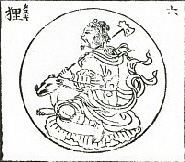
Tanuki (狸), 6th Day, North
|
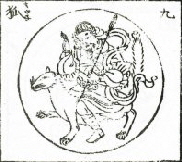
Fox (Kitsune 狐), 9th Day, North
|
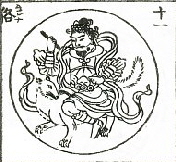
Mujina (狢), 11th Day, East
|
|
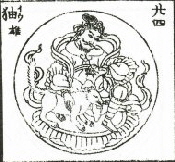
Male Cat (Yū  ), 24th Day, South ), 24th Day, South
|
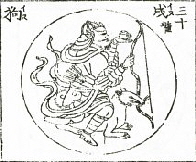
Female Dog (Inu 狗), 30th Day, West
|
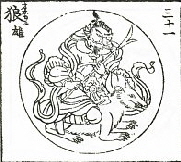
Wolf (Ōkami 狼), 31st Day, West
|
|
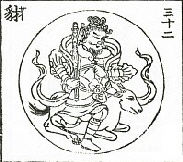
Jackal (Sai 豺), 32nd Day, West
|
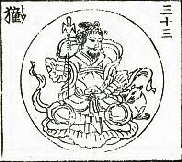
Dog (Tō  ), 33rd Day, West ), 33rd Day, West
|
Eight of the Thirty-six
Calendar Animals
Sanjūroku Kingyōzō
三十六禽形像
|
|
|
|
|
 |
|
|
|
|
|
18th Century Tanuki & Mujina Artwork
|
|
|
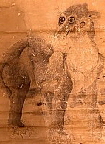
Mujina door-panel painting.
by Soga Shōhaku 曽我蕭白 (1730-1781), Asada-ji
朝田寺. Photo J-site.
|
|
Below are three drawings by Toriyama Sekien 鳥山石燕 (1712-1788). In his artwork, Sekien depicts the Mujina (not the Tanuki) as the shape shifter, suggesting that the nebulous Mujina is more skilled than the Tanuki. Japan’s Mujina legends do in fact predate Tanuki legends. From the 8th-century Nihongi we learn mujina have the power to change into humans, and also that one carried a mysterious pearl with supernatural power in its stomach (similar to foxes in Chinese/Japanese lore, which possess a round jewel of great power). The mujina thereafter surprisingly disappears from Japanese literature and does not resurface until the 18th century -- by which time it was easily confused/conflated with the popular Tanuki. Both creatures are mischievous shape-shifting fox-like spooks who disguise themselves as monks or hags or Buddhist divinities, haunt houses, and play pranks on unwary humans. Today, however, they are harmless rogues who help and amuse more than annoy. |
|
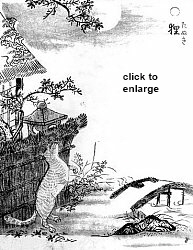
|
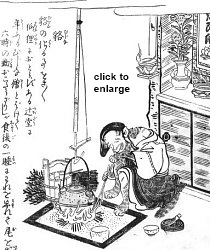
|
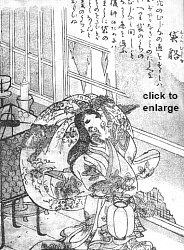
|
|
Bake Danuki 化け狸 (lit. = shape-shifter Tanuki) from the 1776 Gazu Hyakkiyakō 画図百鬼夜行 (Illustrated Night Parade of 100 Demons). Tanuki gazing at the moon was a common artistic theme in Japan’s Edo era.
PHOTO: J-site 1 || 2 || 3
|
Mujina 貉 momentarily assumes its animal form while making tea; from 1781 Konjaku Gazuzoku Hyakki 今昔画図続百鬼 (Continued Illustrations of Many Demons Past and Present). The tea-kettle theme is related to the Bunbuku Chagama tale.
PHOTO: J-site 1 || 2
|
Fukuro Mujina 袋貉 (lit. "bag mujina") from the 1784 Hyakki Tsurezure Bukuro 百器徒然袋 (Idle Collection Bag of Many Things). Fukuro means both "bag" and "bag of tricks." Here a female-like Mujina wears sack-like clothes & carries a heavy bag over its shoulder. PHOTO: J-site 1 || 2
|
|
|
|
|
|
 |
|
|
|
|
|
|
18th, 19th, 20th Centuries - Tanuki Under the Moon
|
|
The moon is a common theme in Japanese Tanuki lore and artwork, for it is on moonlit nights that the creature performs its beguiling belly drumming and mischievous shape-shifting. In the popular tale Kachi Kachi Yama, Tanuki is traveling to the moon in a mud boat when it is killed. Japan’s Tanuki derives from China’s old fox lore, and in China, the fox is considered nocturnal. In old Chinese and Japanese texts, the howling of a fox or tanuki under the moon was considered largely a bad omen, but in some cases it could portend good luck. <See, for instance, the 14th century Nichū Reki 二中暦, a Japanese zodiac calendar. It describes the bad and good omens portended by the howling of foxes and tanuki. Also see De Visser, p. 13.> In Europe, too, tales of the werewolf (a fox-like creature) are common and linked to evil acts performed on moonlit nights, including tales from Hungary, Romania, Albania, and elsewhere.
|
|
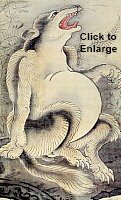
|

|
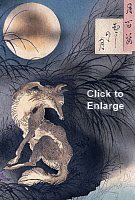
|
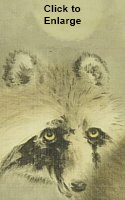
|
|
Tanuki Howling at Moon.
By Soga Shōhaku 曽我蕭白 (1730 - 1781).
H = 124 cm, W = 15 cm.
Photo this J-Site
|
Tanuki & Moon 月小狸.
By Katsushika Hokusai
葛飾北斎 (1760 to 1849).
Photo this J-Site
|
Tanuki & Moon by Yoshitoshi Tsukioka 月岡芳年 1839-1892. From 100 Aspects of the Moon (Tsuki Hyakushi 月百姿).
Photo this J-Site
|
Tanuki & Moon
By Suisen Inoue Shūjō
水仙井上秀城 (b. 1941).
Available for online
purchase at this E-Site
|
|
|
|
|
|
|
 |
|
|
|
|
|
|
Edo Period Tanuki Masks -- Kyōgenmen 狂言面
|
|
Kyōgenmen 狂言面 are masks used for Kyōgen 狂言 plays. Kyōgen is a comic theater form, often performed between acts of the more serious Nō 能 theater, and known as Sarugaku 猿楽 during the Muromachi era (15th-16th centuries). Other animals commonly appearing in Kyōgen plays are the fox and monkey. The Kyōgen play known as Tanuki no Hara Tsuzumi 狸の腹鼓 (Tanuki's Belly Drum) is very recent, written in 1842. In it, Tanuki is female and disguises itself as a nun. She chants an account of the horrors of hell befalling those who kill the animal, and thereby convinces the hunter to stop pursuing the beast. Later, however, the hunter discovers her true identity and begins the hunt once more.
|
|
click to enlarge
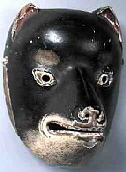
|
click to enlarge
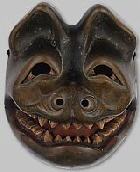
|
click to enlarge
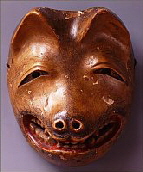
|
click to enlarge
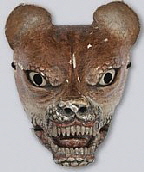
|
|
Tanuki Mask
A Kyōgenmen 狂言面,
or mask used for comical Kyōgen plays. Dated between the 15th-17th centuries. Photo from
Wakayama Museum
|
Tanuki Mask
Used in Kyōgen scene
when hunting Tanuki, hence
named I-Tanuki 射狸,
lit. “Shot-Upon Tanuki.”
Photo Information-Technology Promotion Agency of Japan
|
Tanuki Mask
For Kyōgen play Tanuki no
Hara Tsuzumi 狸の腹鼓
(Tanuki's Belly Drum)
Dated to 19th Century.
Photo from the
Tokugawa Art Museum
|
Fox Mask
Other animals appearing in
Kyōgen plays include the fox
and monkey. Presented here
for comparative purposes.
Photo Information-Technology Promotion Agency of Japan
|
|
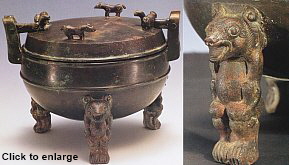
|
Photo at left. Bronze ding (cauldron) tripod with bear-shaped legs. Western Han China, 2nd century BCE. H = 18.1 cm, diameter = 20 cm. Excavated in 1968, from tomb 1, Han tombs at Mancheng, Hebei Provice. Hebei Provincial Museum. Photo from exhibition catalog (p. 147) entitled Treasures of Ancient China, Oct. 24 - Dec. 17, 2000, Tokyo Nat’l Museum, Published by Asahi Shimbun. The catalog notes the “bear-shaped legs.” But in many ways, this looks like a Tanuki -- as can be seen by viewing the many photos on this site page. Nonetheless, Tanuki lore and artwork are essentially non-existent in China..
|
|
|
|
|
|
|
 |
|
|
|
|
|
|
Edo Period Tanuki Netsuke 根付
|
|
Netsuke 根付. Ne 根 means "root" while tsuke 付 means "attach." Netsuke are miniature sculptures that appeared around the 17th century. They were attached to one's belt to hold a larger container (inrō 印籠) which carried tobacco, medical powders, etc. Says JAANUS: “A netsuke and inrō were connected by a double cord with a sliding bead (ojime 緒締) which tightened the cord and held the tiered sections of the inrō together. The netsuke, fastened on one end of the cord, was then slipped under a man's narrow belt (obi 帯), allowing the inrō or other small articles (a tobacco pouch, for instance) to hang freely at his side. Travelers used these small cases to carry pills, medicinal powders, and other personal items.” Read full entry at JAANUS. To learn more, see the Meinertzhagen Card Index on Netsuke in the Archives of the British Museum (two-volume facsimile version still available on used-book market), the International Netsuke Society and the article by Kendall Brown in its 1997 journal entitled “Why Art Historians Don't Study Netsuke and Why they Should,” and the illustrated version of The Hare with Amber Eyes (2011) by Edmund de Waal. For a review of the latter, please click here.
|
|
click to enlarge
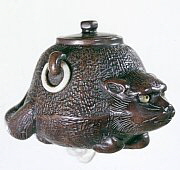
|
click to enlarge
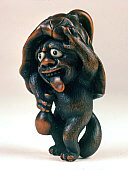
|
click to enlarge
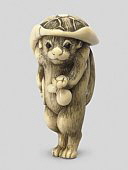
|
click to enlarge
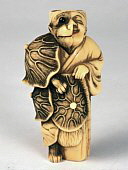
|
|
Tanuki as tea kettle.
Wood. Signed Sosui. Photo from International Netsuke Society.
See Lucky Tea Kettle story below.
For photo source, see here.
|
Tanuki with sake flask, wearing lotus-leaf hat. Wood. Signed Tomokazu. Photo International Netsuke Society. <Source>
|
Tanuki. Ivory. Late 18th century, Kyoto School. Wears lotus-leaf hat, carries gourd & drum. Photo from Christie’s.
|
Tanuki shifting into monk. Ivory. Kyoto School. Photo from International Netsuke Society. <Source> See Tanuki dressed as monk.
|
|
NOTE: The above netsuke are tentatively dated between the mid-18th and mid-19th centuries.
|
|
|
|
|
|
|
 |
|
|
|
|
|
|
19th Century - Tanuki’s Big Belly and Belly Drum
Belly Drum Tanuki, Hara Tsuzumi Tanuki 腹鼓狸 or Tanuki no Hara Tsuzumi 狸腹鼓
|
|
The origin of Tanuki’s big paunch and belly-drumming magic is unclear (to me), but various 18th-century Japanese texts mention these attributes and extant 19th artwork portrays it. For possible origins, see below. In the 1742 Japanese text Rō-ō Chawa 老媼茶話 (Tea Talk from Old Women), we read of an old tanuki who was saved by a child. The tanuki then requested to live under the veranda of the child’s home. The request was granted, and the tanuki was thereafter fed daily by the child’s father, and in return the creature entertained the household nightly by playing his belly drum. In the 18th-century Shōnai Kasei Dan 庄内可成談, we read about belly-drumming music on clear autumn nights. In many legends, the tanuki’s drumming is meant to beguile travelers and lead them astray, but we must also note that in popular belief, the Tanuki get together now and then just for fun, to make merry and dance in abandoned shrines or fields under the moonlight. Art historian Katherine M. Ball (1859-1952) says only tanuki who have reached 1000 years in age can play the belly drum (p. 141), although she fails to give any reference. Tanuki’s belly drumming may have been known centuries earlier, for a poem by Jakuren 寂蓮 (aka Fujiwara no Sadanaga 藤原定長, death 1202) goes: “An old monastery, where nobody lives, where even the bells give never a sound, and tanuki alone beat the temple drum.” <De Visser, pp. 71-72, 102, 156>
|
|
click to enlarge
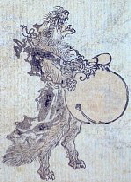
|
click to enlarge
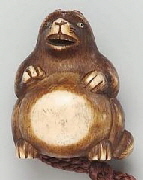
|
click to enlarge
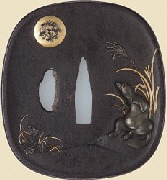
|
click to enlarge
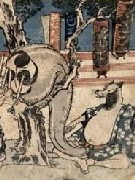
|
|
Tanuki howling while beating a mokugyo 木魚 (wooden fish gong). By Kawanabe Kyōsai 河鍋暁斎 (1831-1889), c. 1881. Spoof on Buddhist monks who regularly use mokugyo during recitations of mantra & sutra. Photo J-site
|
Netsuke in the form of a
Tanuki drumming on its belly; attached to container with Kotobuki 壽 (long life) etched on its cap. Japanese, Late 19th century. MFA Collection (Boston). Explore all Tanuki artwork at the Museum of Fine Arts Boston.
|
Tsuba 鐔 (sword guard) with design of a Tanuki drumming on its belly beneath the moon. Japanese, Mid-19th C, by Takahashi Yoshitsugu (1842–1873) of the Tanaka School of artists. MFA Collection (Boston).
|
Tanuki (as retailers) celebrate the first sale of the new year by beating on a large “scrotum” drum. By Utagawa Kuniyoshi 歌川国芳 (1798-1861). Photo KuniyoshiProject.com. See below for details on Tanuki’s large scrotum.
|
|
Tanuki Bayashi 狸囃子. “An example of uncanny sounds,” says scholar Gregory Smits, “would be Tanuki Bayashi 狸囃子 (literally ’tanuki accompaniment’). In this case, in the dead of night, a lone person suddenly hears the sound of festival drums. But the drums sound a little odd, and the sound seems to have come out of nowhere and its direction is hard to pinpoint. Surprised, the hearer tries to get a fix on the sound, but it fades away. There is no festival or any other occasion for drumming anywhere nearby. What is going on? According to Japanese lore, the drumming is that of an animal trickster known as a tanuki. Indeed, children in Japan today are likely to be able to sing a one-verse song ditty that goes: Tan, tan, tanuki no kintama wa; kaze ni fukarete bura bura (features onomatopoeia, but, roughly: The tanuki's balls are blown back and forth by the wind). Anyway, the eerie sound of mysterious drumming at night was thought to be the result of one or more tanuki drumming on their bellies or (ouch) scrotums.” <end quote>
In some stories, the Tanuki is so enraptured by musical excitement that he beats (drums) his belly bare and dies, or enlarges his tummy to such great girth that he bursts. See, for example, the 1875 story from the Edo Tōkyō Kaii Hyaku Monogatari. PHOTO: Honjo Nanafushigi no Uchi 本所七不思議之内 (Seven Wonders of Honjo), by Utagawa Kuniteru 歌川国輝 (fl. 1830-1850), Waseda Univ.
|
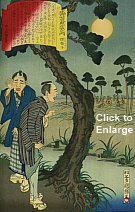
Tanuki Bayashi 狸囃子
Group of Tanuki beat their bellys under the moon.
See artwork citation
in adjacent column.
|
|
|
|
|
|
|
|
|
|
|
|
|
|
ORIGINS OF BIG BELLY & BELLY DRUMMING
|
|
|
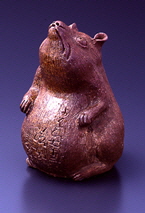
Tanuki Te-aburi 狸手焙り by Ōtagaki Rengetsu 大田垣蓮月 (1791-1875). A te-aburi is a hand warmer or heat radiator. Ōtagaki was a Buddhist nun and skilled poet, potter, painter and calligrapher. Photo Shigaraki Ceramic Cultural Park or SCCP
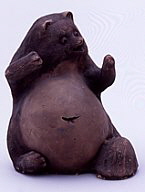
Pudgy Tanuki, Ceramic
Early Shōwa era, c. 1920s.
By Imai Ri-an 今井狸庵, Kyoto, Kiyomizu. Photo from Shigaraki Ceramic Cultural Park or SCCP
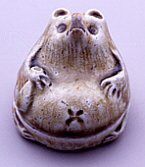
Tanuki Incense Burner, Shigaraki
信楽狸香合, by potter
Tani Toshitaka 谷敏隆 (b. 1943). Photo from Shigaraki Ceramic Cultural Park or SCCP
|
|
In extant Japanese artwork, Tanuki’s big belly and tummy-drumming magic clearly predate Tanuki’s large scrotum and nut-bag thumping. Yet the origin of Tanuki’s large abdomen and unusual musical talents remain shrouded in the mists of uncertainty. Thankfully there is ample circumstantial evidence to allow us to make “educated guesses” -- to conjure up explanations that sound very plausible. Below are some of mine. Any one of them may be the origin of the other, or they may all have developed in tandem and interactively, but it is impossible to say.
- OBSERVATION. The magical animals of Chinese and Japanese mythology are commonly depicted with personalities, which are based on a combination of fact, observation, and folklore. The real Tanuki is a stout beast who “stuffs itself with fruit and berries in the fall and spends the winter in communal dens in a period of lethargy and quasi hibernation.” (David Macdonald, Oxford, 1992, pp. 83 & 173). This helps to explain Tanuki’s inflated belly.
- LINGUISTIC (WORD PLAY). Stuffing oneself and then sleeping it off implies a life of ease, comfort, and contentment. It also implies a pot belly. The Japanese term KOFUKU 鼓腹 (鼓 = drum, 腹 = stomach) means just this -- to live a life free of care, to eat until one is full, to suffer no dissatisfaction, no discomfort. In common usage, KOFUKU means “to pat one’s belly” as a sign of satisfaction. But wait !! Reverse the characters and it becomes HARA TSUZUMI 腹鼓, literally “belly drum.” Incidentally, the pot-bellied Buddhist divinity Hotei (one of Japan’s Seven Lucky Deities) is known as the God of Contentment & Happiness. It is no stretch of the imagination to say that a well-fed carefree life brings plumpness and girth, which throughout most of Asia signifies the good life, the happy life, the lucky life. The pudgy Tanuki statues one sees everywhere in modern Japan thus signify prosperity and wealth.
- SOCIAL SATIRE. Tanuki appear often in artwork in the disguise of a fat well-nourished Buddhist monk sitting on a cushion. Tanuki are also occasionally represented beating a wooden drum called the mokugyo 木魚 (fish gong), as in the drawing by Kawanabe Kyōsai (1831-1889) shown above. Buddhist monks (then & today) regularly use mokugyo during their recitations of mantra and sutra. “These representations of Tanuku,” says scholar U.A. Casal (pp. 56-57), “are not exactly a compliment to that fraternity. But Buddhist priests, the same as the Catholic ones in Europe, were at times and by certain groups considered no better than charlatans ensnaring the credulous, especially the women. They were thus deemed to be rather dangerous fellows destroying in the end those whom they pretend to save. The Tanuki Bōzu 狸坊主 (monk) is the sly but ruthless individual to whom any pretext and deception, even an apparent piousness, will serve his ends.”
- MUSIC. Tsuzumi or Tsutsumi 鼓 is a drum, thought to have originated in China or Korea. Shaped like an hour-glass, and played with the hands, it is used frequently in traditional Japanese music and Noh theater. The belly-drumming Tanuki is known as Hara Tsuzumi Tanuki 腹鼓狸. The sound produced by Tanuki’s belly drum in traditional times was said to be dokodon dokodon dokodon, or simply don don don. In modern times, the sound is given as ponpoko pon pon ポンポコ、ポン、ポン, which the Tanuki is also said to “sing.” The fox, when happy, cries kon kon. In the real world of Japanese music, Tsuzumi produce the main upstroke sound “don.” <see Ashgate Research Companion to Japanese Music, pp. 138-139; also hear digital sound sample at this E-site>. Additionally, Casal (pp. 56) says “I wonder whether this ’drumming’ idea is not a faint memory of the message-drums of south-sea islanders -- a strong influx into Japan certainly came from that quarter.”
Shikitei Sanba (Samba) 式亭三馬 (1776-1822), a well-known writer of Kokkeibon 滑稽本 (humorous books), wrote a piece entitled Hara Tsuzumi Tanuki Tadanobu 腹鼓狸忠信 (True Stories of the Belly-Drumming Tanuki) -- see his work at the University of Tokyo Digital Archives. Shikitei is more widely known for his Ukiyoburo 浮世風呂 (The World at the Bath-House; 1809-13) and Ukiyodoko 浮世床 (The World at the Barber Shop; 1813-14).
|
|
|
|
|
|
|
 |
|
|
|
19th Century - Tanuki’s Giant Scrotum (Nut Sack)
|
A curious and defining characteristic of Tanuki is its gigantic scrotum (not testicles). In Japanese slang, these are known as Kinbukuro 金袋, or “money bags.” Tanuki’s large scrotum does not mean over-indulgence in sex, but rather “luck with money.” The most accepted explanation for his king-size nut sack comes from Ōwaku Shigeo 大和久重雄 in his book Hagane no Chishiki 鋼の知識 (Knowledge about Steel; Diamond Shakan, 1971). Writes Alice Gordenker in the 15 July 2008 Japan Times: “Ōwaku traces the super-size scrotum story to metal workers in Kanazawa Prefecture. To make gold leaf, these craftsmen would wrap gold in a tanuki skin before carefully hammering the gold into thin sheets. It was said that gold is so malleable, and tanuki skin so strong, that even a small piece [of gold] could be thinned to the size of eight tatami mats (Hachijōjiki 八畳敷き; about 12 sq. meters). And because the Japanese for ’small ball of gold’ (kin no tama 金の玉) is very close to the slang term for testicles (kintama 金玉), the eight-mat brag got stuck on tanuki's bag. Soon, [scrotum] images of a tanuki began to be sold as prosperity charms, purported to stretch one's money and bring good fortune.” <end quote> In the same story, Gordenker discusses popular school-yard songs celebrating the Tanuki’s large sack. “Tan-tan-tanuki no kintama wa, kaze mo nai no ni, bura bura.” (translation = Tanuki's balls, there isn't any wind but they still go swing, swing, swing). <end quote Gordenker>
In many Tanuki legends, the scrotum is stretched to the size of eight tatami mats. Yet others point to the word Senjōjiki 千畳敷き (1,000 tatami mats) as an indication of Tanuki’s scrotum-inflation magic. In Japan, the scrotum and testes are symbols of good luck rather than overt sexual symbols. In the Japanese movie Heisei Tanuki Gassen Ponpoko, the Tanuki stretches out its scrotum and uses it as a parachute in a desperate suicide attack against the money-grubbing humans. The 18th & 19th centuries were apparently a heyday for low humor. See Robin D. Gill’s Octopussy, Dry Kidney & Blue Spots - Dirty Themes from 18th -19th Century Japanese Poems, Paraverse Press 2007, starting page 177 and including the section on Senki-mochi 疝気持 or Lumbago. Gill writes that Tanuki’s “scrotal skin was used to pound out gold-leaf [by metal workers], someone got confused about what stretched, and graphic artists had so much fun finding uses for enormous balls that the mistake stuck for centuries.” <p. 183> Today, Tanuki’s large scrotum represents “luck with money” and “expanding wealth” -- it is in no way connected to sexual indulgences, as most web sites so falsely convey. |
|
19th Century - Tanuki’s Scrotum Slideshow (34 photos)
|
|
In the 19th century, various Japanese artists created numerous (and humorous) woodblock prints showing the Tanuki's large scrota, nut sack, kinbukuro 金袋 (money bags, gold bags), or kintama 金玉 (golden balls) in creative ways. Such artists included the famed Utagawa Kuniyoshi 歌川国芳 (1798-1861), Tsukioya Yoshitoshi 月岡芳年 (1839-1892), and Kawanabe Kyōsai 河鍋暁斎 (1831-1889).
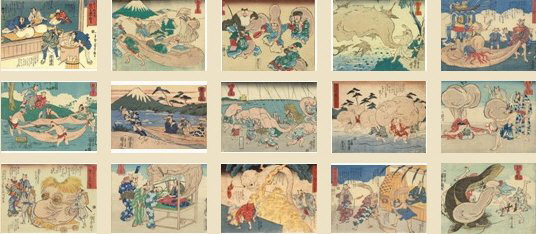
Click above image to jump to slideshow
|
|
|
21st Century - Tanuki’s Scrotum on Commerical TV
|
|
Click above image to view ad
by Japanese construction firm
Anabuki Kōmuten 穴吹工務店.

Snippet of commercial from
former student at UAT.
See this E-site.
|
This ad from a Japanese construction firm, released sometime around 2005 / 2006, involves Tanuki and Little Red Riding Hood (Anabuki-kin-chan). It portrays Tanuki as one of Little Red Riding Hood’s many forest friends, one whose large nut sack represents “magnifying” one’s dreams and hopes (playing upon the traditional “expanding money bag” symbolism of Tanuki’s giant scrotum). The ad’s message -- join us & you too can have a huge wonderful home. Below translation from this E-site.
- Announcer: The new campaign girl for Anabuki Kōmuten (Anabuki Builders) is the girl you know so well...Anabu-kin-chan! (Little Red Riding Hood!). What's this? All the animals of the forest are here too! All together, let's read with spirit.
- Chorus of girls' voices: Anabu-kin-chan!
- Anabu-kin-chan: Hai (Yes, I’m here & ready!). Then she sings:
It makes your dreams expand, Saabasu Mansion
It makes your hopes expand, Saabasu Mansion
It also makes your breasts expand, expand, expand.
- Suddenly, a Tanuki with enormous nut bags appears.
- Anabu-kin-chan: Wow! ********
- Anabu-kin-chan: Saabasu Mansion
- Commericial Announcer: Anabuki Kōmuten (Anabuki Builders)
Note: Saabasu Mansion is name of real estate they hope to sell.
|
|
|
|
 |
|
|
|
|
|
|
19th Century - Other Artwork
|
|
The new shōgun, Tokugawa Ieyasu 徳川家康 (+1542-1616), gains complete hegemony in Japan with his victory over the Toyotomi 豊臣 family in +1615, and thereafter Japan enjoys over 250 years of peace and prosperity under the leadership of 15 generations of Tokugawa shōguns 将軍 (military rulers). The military capital was established in Edo 江戸 (modern-day Tokyo), and secular arts of all kinds flourished among the growing merchant classes, military clans, and the wealthy. Since then, the importance of secular art has forever surpassed that of religious art. Ieyasu, by the way, was irreverently nicknamed Furu Tanuki 古狸 (Old Tanuki), for he was considered a very clever schemer. Additionally, the symbol for eight (hachi 八) appears often inside a circle on Tanuki’s sake bottle. This symbol ㊇ was the old crest (mon 紋) of the Tokugawa family in Owari (present-day Aichi prefecture) and represented the eight districts they once controlled. See What About Hachi below.
|
|
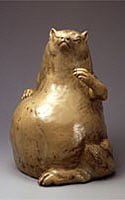
|
click to enlarge
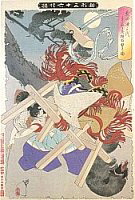
|
click to enlarge
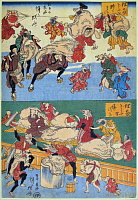
|
click to enlarge
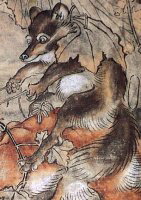
|
|
Tanuki Beating Belly Drum
Ceramic, Late Edo Period
by Miwa Kiraku Vl
三輪喜楽 (6代)
Miwa Kiraku the 6th is was one of the most prolific potters of okimono (realistic figurines); his motifs include the shishi lion & Tanuki.
Photo Asahi Article
|
Takeda Defeats Tanuki,
by Tsukioka Yoshitoshi
月岡芳年 (1839 - 1892) from
New Forms of 36 Apparitions (新形三十六怪撰 or Shinken Sanjyuroku Kaisen).
Photo this J-Site.
** See note below **
|
Tanuki Using Giant Scrotums in Funny Ways, by Kawanabe Kyōsai 河鍋暁斎 (1831-1889). Circa 1864. In top frame, lion dance (Shishimai 獅子舞) and parade. In bottom frame, the Pounding of Rice Cakes (Mochi Tsuki 餅つき). A spoof on Japan’s popular festivals. Photo this J-site.
|
Tanuki atop fox
along with frogs and owl.
Kawanabe Kyōsai 河鍋暁斎 (1831-1889). Spoof of a 12th-century hand scroll known as Frolicking Animals & Humans or Chōjū Jinbutsu Giga 鳥獣人物戯画. Photo this J-site.
「梟と狸の行列」
鳥獣戯画画稿
|
|
NOTE: In the second photo above (Takeda Defeats Tanuki) and also in the additional photo shown at right, we should perhaps add that Takeda Shingen 武田信玄 (1521-1573) was a powerful daimyō and military leader in feudal Japan. In these paintings, Tanuki assumes the form of a saddle-horse and asks the young Takeda a strategic question. Takeda is angered and uses his sword to strike the saddle, killing the Tanuki (who then returns to his true form). Entitled 田勝千代月夜に老狸を撃の図. Photo at Right. Takeda Defeats Tanuki. By Tsukioka Yoshitoshi 月岡芳年 (1839- 1892). Photo this J-site |
|
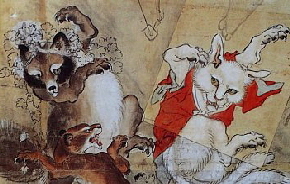
Tanuki and Cat. By Kawanabe Kyōsai 河鍋暁斎 (1831-1889).
A spoof of a 12th-century hand scroll known as Frolicking Animals & Humans (Chōjū Jinbutsu Giga 鳥獣人物戯画). The latter work is a national treasure at Kōzan-ji Temple 高山寺 (Kyoto). Above photo this J-site. See also this J-site and this E-site. Nonetheless, this looks like a Tanuki and White Fox. A wild dog snarls at the white fox (his natural enemy). Plus, by this time, Inari, Dakini, Benzaiten, and Izuna Tengu all ride white foxes, and fox statuary in Japan is often adorned with a red scarf, hat, or bib (a talisman against disease).
|
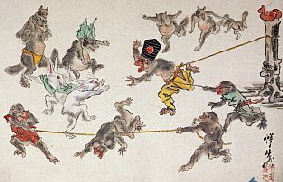
Tanuki and other frolicking animals, c. 1879
by Kawanabe Kyōsai 河鍋暁斎 (1831-1889).
杭に繋がれた猿と兎、狸. Photo this J-site.
A 19th-century spoof of a 12th-century hand
scroll known as Frolicking Animals & Humans
or Chōjū Jinbutsu Giga 鳥獣人物戯画.
|
|
|
|
 |
|
|
|
Meiji Era (1868-1912)
|
|
By the late 19th century, the individual components of Tanuki lore begin to coalesce in artwork. In the decades that follow, these components (big belly or wide girth, sake flask, promissory note, straw hat, giant scrotum, large round eyes, goofy facial expression) become the standard attributes of Tanuki statues -- with the main iconic type we know today established by at least the Taishō Era (1912-1926).
|
|
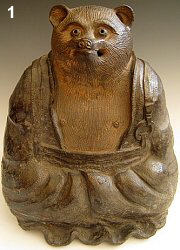  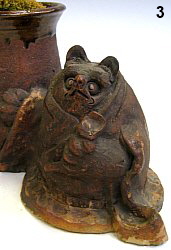
1. Ceramic Tanuki Dressed as Monk. Meiji Era. H = 12 inches. Photo from jcollector.com
2. Wood Tanuki Procuring Sake. Meiji Era. H = 16 inches. Wood. Photo from jcollector.com
3. Ceramic Tanuki as Monk, with Ikebana Flower Vase. Meiji Era. H = 7 inches. Photo from jcollector.com
View all Tanuki pieces offered by jcollector.com
|
|
|
|
Tanuki Dressed as a Monk (19th & 20th Centuries)
|
|
Tanuki as a Monk (Bōzu Tanuki 坊主狸 or Tanuki Bōzu 狸坊主). A common theme in Tanuki lore and artwork, wherein Tanuki disguises himself as a fat well-nourished Buddhist monk (see discussion of iconography under Big Belly). The tanuki, mujina, and fox appear often as trickster priests in Edo-era Japanese tales. For instance, in the Japanese text Shinchomonshū Ryakki 新著聞集畧記 (circa 1700), we learn about an old spook monk who lived nearly 200 years at a certain monastery. Over that time he saved many gold pieces from donations. But when he was killed by a dog, his true mujina form was revealed. The abbot gave the gold to two laborers who had discovered the dead mujina, but the money was cursed, causing madness and death to the family of one of the two laborers. The other erected a stone monument for the dead monk and held a funeral service. <see De Visser pp 77-79>
|
|
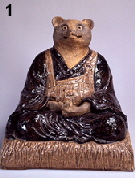 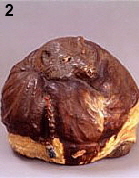  
- Ceramic Tanuki dressed as chief bonze (monk), entitled Oshō Tanuki 和尚狸, Meiji Era, by Nin-ami Dōhachi 仁阿弥道八 (1783-1855). Located at the Tokyo National Museum (TNM). Photo TNM. Click image to enlarge.
- Ceramic Tanuki dressed as a plump monk, Rakuyaki Tanuki Te-aburi 楽焼狸手焙, by Ishiguro Munemaru 石黒宗麿 (1893-1968), H = 25 cm, Late Taishō era. Rakuyaki is low-fired ceramic ware. Photo Asahi article.
- Stone Tanuki at Zuisenji Temple 瑞泉寺 in Kamakura. Late Taishō / Early Shōwa (guesstimate). This statue looks like a fox, but the enormous girth of the statue, plus the slightly bewildered expression on its face, helps to identify it as a Tanuki. Photo by Schumacher
- Ceramic Tanuki dressed as a monk, holding begging bowl and rosary. Modern. Located in front of the Taishidō 太子堂 (hall dedicated to Shōtoku Taishi) at Kanjizai-ji Temple 観自在寺, Shikoku. Photo from now-defunct J-website.
|
|
|
|
 |
|
|
|
|
Meiji Era (1868-1912) Tanuki Artwork
|
|
In the late 19th century, as Japan races to modernize and catch up with the West, the Tanuki is used as an “educational vehicle” -- as an example of backward thinking that needs to be overcome.
|
|
click to enlarge
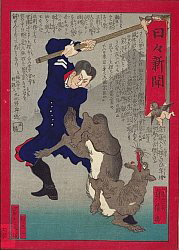
Bunbukusha's Trickster Tanuki Assumes 9 Different Guises.
Bunbukusha-chū no Tanuki-oyaji Kyūbake Yarō
文福舎中の狸親父九化野郎
By Hasegawa Sadanobu 二代 長谷川貞信 (1848-1940). The tanuki is a familiar character of folklore known for outwitting human beings by changing into various forms. This trickster creature of popular superstition, according to this story, has finally been captured by the junsa, a policeman symbolic of "enlightened" (modernized) society after the Meiji Restoration of 1868. The truth of the story aside, the "enlightening" tone of the passage toward the end of the article gives a glimpse of the popular psyche of those days. Appeared originally in the Nichinichi Shinbun 日々新聞, Meiji era. Photo and Text from Waseda University Library.
|
click to enlarge
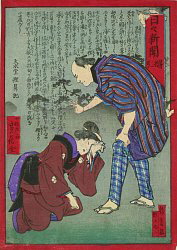
Gambler thoroughly deceived by
a Tanuki disguised as a woman
まんまと狸にだまされた相場師
By Hasegawa Sadanobu
二代 長谷川貞信 (1848-1940)
The title is akin to "a rogue being swindled by a rogue."
Japanese text by Taisuido Risho 大水堂狸昇.
Appeared originally in the
Nichinichi Shinbun 日々新聞
Meiji era
Photo from Waseda University Library.
|
|
|
|
|
 |
|
|
|
Taishō Era (1912-1926)
|
|
The prototype of today’s pudgy ceramic Tanuki statue emerged in the early 20th century. This iconic type depicts him wearing a straw hat, holding a sake flask in one hand, a promissory note in the other, and sporting a giant scrotum, big belly, large round eyes, and a somewhat goofy facial expression. It is commonly known by the name Sake Kai Tanuki 酒買狸 (literally Tanuki Procuring Sake) and draws its inspiration from an old children's song (16th-17th century) in the Osaka and Kyoto sake-brewing areas (details here). The four images below come from a Tanuki exhibit held by the Shigaraki Ceramic Cultural Park (SCCP) from March 17 to June 3, 2007. See SCCP and Yakimono Guide (Asahi.com).
|
|
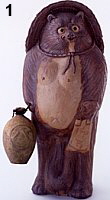  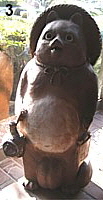 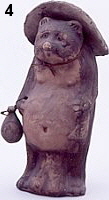
- Sake Kai Tanuki 酒買狸 (Tanuki procuring sake), Shigaraki Okimono, by Fujiwara Tetsuzō 藤原銕造 (1876-1966). Fujiwara Tetsuzō is commonly considered the father of Tanuki ware made in Shigaraki, which has since become Japan’s preeminent location for mass-produced ceramic Tanuki statues. Photo SCCP.
- Sake Kai Tanuki 酒買狸 (Tanuki procuring sake), Shigaraki Okimono, by Fujiwara Otoshiro 藤原乙次郎, H = 122 cm. Late Taishō Period. Photo Asahi Story.
- Sake Kai Tanuki 酒買狸 (Tanuki procuring sake), Okimono, by Matsushita Fukuichi 松下福一, Late Taishō / Early Shōwa, Tokoname Folk Crafts Research Center 常滑市民俗資料館蔵 in Aichi Prefecture. Photo Asahi Story.
- Sake Kai Tanuki 酒買狸 (Tanuki procuring sake). Early Shōwa era, c. 1920s. H. = 30.4 cm. By Imai Ri-an 今井狸庵, Kyoto, Kiyomizu. Photo SCCP and Asahi Story.
  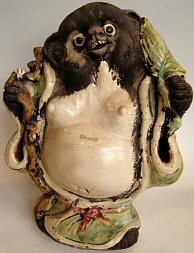
Three Glazed Ceramic Tanuki -- from www.jcollector.com
Taishō Era (1912-1926). Two statues wear a straw hat and hold a sake bottle and promissory note.
One statue holds a leaf, which it puts on its head prior to shape-shifting. JCollector says: “Tanuki
was adopted as a symbol of aristocratic excess during the Edo period. Often displayed in front of
sake houses to hint at the entertainment offered therein.” <end quote>
|
|
|
|

|
20th and 21st Centuries (Contemporary Japan)
|
|
Today Tanuki is an extremely popular icon of generosity, cheer, and prosperity -- he has lost all his evil and frightening attributes and become instead a cute icon of wealth and luck. Pudgy ceramic statues of Tanuki are found everywhere, especially outside bars and restaurants, where a goofy Tanuki effigy typically beckons drinkers and diners to enter and spend generously. Since Tanuki’s large scrotum symbolizes “expanding weath” and “luck with money,” Tanuki is also considered a wealth-bringing icon, one that adorns residential gardens and public spaces. As a bringer of wealth, he has been appropriated by Japan’s commercial interests, and appears in key chains, cell-phone straps, bakery goods, comic books, cartoons, movies, and all endeavors bent on making money.
|
|
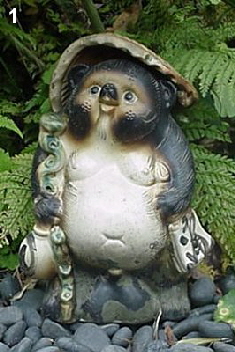 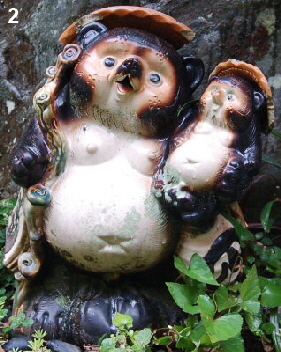
1. Modern Ceramic Tanuki, Private Garden, Kamakura, Japan.
2. Modern Ceramic Tanuki w/child. Private Garden, Kamakura.
This is a very interesting statue, suggesting the themes of fertility and parenthood. But if you look closely,
Tanuki seems to be both male and female, as per the large breasts and the large nut sack. In fact, many
modern male Tanuki statues are depicted with big breasts. Perhaps this is “meant” to symbolize both
male-female qualities. Or perhaps I am overthinking the issue. Just a curious aside.
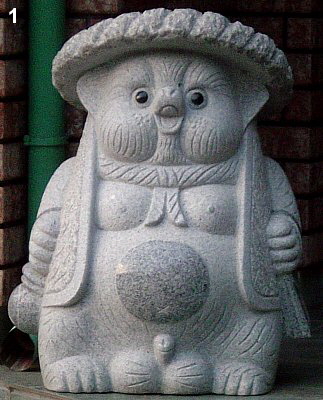 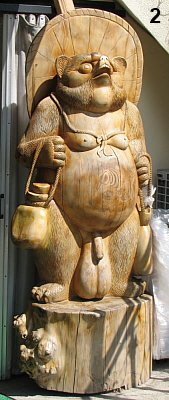
Modern Tanuki statues with male member still intact !!!
It is still generally uncommon to find statues of Tanuki with the “male member” still intact.
1. Stone statue outside shop in Kamakura City. Photo by Mark Schumacher.
2. Wood statue near Mt. Unzen 雲仙岳, Nagasaki Pref. (Kyūshū). Photo by Baron Knoxburry.
|
Donald Richie, in his review of Nicholas Bornoff’s book Things Japanese, has this to say: “The Tanuki makes an appearance, holding an empty sake bottle in one paw, an account book in the other -- signifying that this money was wasted on wine and women. As Bornoff tells us: ‘Some say that the vast scrotum is due to sexual overindulgences but, since his penis has disappeared, another interpretation is more likely’ -- an entertaining aside from Bornoff, the author of Pink Samurai: An Erotic Exploration of Japanese Society.” <end quote> EDITOR’S NOTE. Richie is wrong about one thing -- Takuni’s sake flask and promissory note do not signify “money wasted on wine and women.” As discussed earlier in this report, Tanuki’s large scrotum represents “expanding wealth” and “lucky with money.” The promissory note derives from Tanuki’s ability to pay “seemingly real” money for his merriment, but after he departs, the unlucky seller discovers that the money is nothing more than worthless pebbles, dirt, and leaves.
|
|
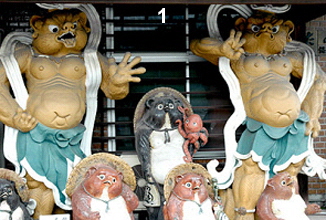 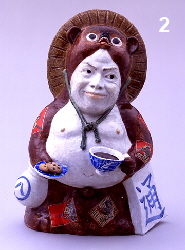
1. Tanuki as two Buddhist guardian deities called the Niō. Photo from this J-site.
2. Tanuki as woman with tea & cookies. By Hirotsune Tashima 田島弘庸 (b. 1969). Photo SCCP (J-site)
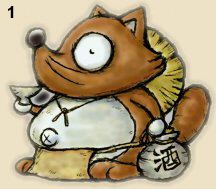 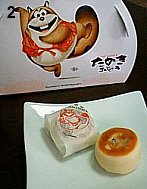 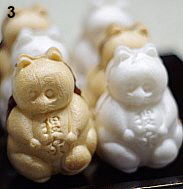
1.Cute sake-drinking Tanuki. Kazuyuki Kurashima 倉島一幸 (b. 1970) Character Designer & Illustrator.
2. Kisaemon Tanuki. Brand character for a Shikoku-made manjū 饅頭 (a sweet bun). Photo from this J-site.
3. Tanuki-shaped sweets. Photo from this J-site.
  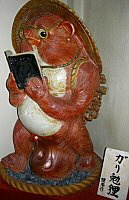 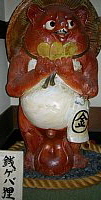
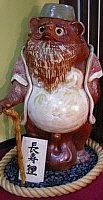
Tanuki statues at the Ikaho Onsen 伊香保温泉 in Shibukawa City 渋川市, Gunma. Photos this J-site.
- Nonbei Tanuki のんべえ狸 (Boozehound Tanuki), drinking sake with a sake cup (guinomi) as a hat.
- Gomasuri Tanuki ゴマスリ狸 (Brown-Noser Tanuki); gomasuri (lit. = grind sesame seeds) is slang for sycophantic behavior. Here we see Tanuki grinding sesame seeds using a bowl and pestle.
- Gariben Tanuki ガリ勉狸 (Eager-Beaver Tanuki). Gariben means to cram, to pound the books.
- Zenigeba Tanuki 銭ゲバ狸 (Money-Power Tanuki). Holding gold coins; symbol for money ㊎ written on his ledger.
- Chōshu Tanuki 長寿 (Long-Life Tanuki). Stands outside onsen entrance; wash basin atop its head.
|
|
|
|
 |
|
|
|
TANUKI ATTRIBUTES (Traditional)
|
|
What About Leaf on Tanuki’s Head?
the Umbrella? the Straw Hat?
The shape-shifting Tanuki is said to put leaves on its heads and to chant prior to transformation -- just as the fox must balance a human scull and bones atop its head before shape shifting. In some legends, the leaf is the sacred lotus plant of Buddhism. It is also believed that Tanuki can change leaves into money (as one of them did in the 1994 hit movie Heisei Tanuki Gassen Ponpoko). In the computer game "Super Mario Brothers," when Mario gets a leaf, he gains pointy ears and the tail of a Tanuki.
Since Japan’s Tanuki is derived from old Chinese fox lore, we must look to China for clues. In the Sōshinki 搜神記 (Chn. = Sōushénjì, Sheu Shen Ki), a 4th-century Chinese text attributed to Gan Bao 干寶 (fl. 317-322), we learn that a devout monk “who passed the night as a grave corpse, saw in the moonlight a wild fox placing withered bones and a skull upon its head, and when the animal after some practice succeeded in moving its head without dropping them, it covered its body with grass and leaves and changed into a beautiful woman.“ <quoted from De Visser, p. 4> In the 8th-century Chinese text Yūyōzasso 酉陽雑俎 (Chn. = Yū Yáng Zá Zǔ, Yu Yang Tsa Tsu), “when the fox desires to appear as a spook, he puts a human skull on his head and salutes the Great Bear constellation.” <quoted from De Visser, p. 5>
Tanuki’s umbrella and straw hat are recent additions. Both appear in Tanuki artwork around the late 19th century (see below photos). Although exact origins are unclear, the “umbrella or straw hat” motif most probably sprang from a popular old song (16th-17th century) in the Osaka and Kyoto sake-brewing areas; one stanza of the song describes a small tanuki (mameda 豆狸) who steals sake on nights of non-stop drizzling rain (details here). Artists no doubt played upon this association with rain and sake, and began depicting Tanuki journeying to the brewery with sake flask and umbrella (or straw hat). In extant artwork, the umbrella predates the straw hat. In contemporary times, however, the straw hat has supplanted both the leaf and the umbrella. Most of the old folklore has disappeared as well. Today, the makers of Tanuki statues say the straw hat symbolizes the virtue of “readiness” -- be prepared for bad weather or bad luck. See Eight Virtues of Tanuki below.
|
|
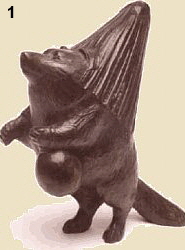  
- Tanuki Okimono 置物 (decorative carving), Meiji Era, artist unknown. This piece shows Tanuki holding an umbrella and carrying a sake flask. Photo from odanuki.com (now-defunct J-website).
- Tanuki Procuring Sake, holding umbrella and sake flask, by Nakamura Fusetsu 中村不折 (1866-1943), Photo from SCCP. I’m not quite sure about the origin of this piece.....it may possibly come from Inezuka Hōdō 稲塚鳳堂画 (Showa-era artist). See photo from the Naganoken Hyōgu Kyōji Naisō Kyōkai 長野県表具経師内装協会.
- Tanuki Procuring Sake on a Rainy Night 夜雨の客, by Komatsu Hitoshi 小松均 (1902-1989), Museum of Modern Art in Shiga 滋賀県立近代美術館蔵. Photo SCCP; also see The Museum of Modern Art, Shiga Prefecture.
|
|
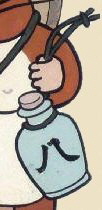
Tokkuri 徳利
|
|
What About Tanuki’s Sake Flask?
Tanuki artwork commonly portrays the creature holding a sake flask (tokkuri 徳利) in his right hand, but sometimes the flask appears in the left hand (no significance should be attributed to this difference). The sake flask depicted today on nearly all Tanuki ceramic statues is commonly traced back to a stanza from a popular old children's song in the Osaka and Kyoto sake-brewing areas. Although the exact date is unclear, the modern Association of Shigaraki Ceramic Companies as well as authorities at the Shigaraki Ceramic Cultural Park (SCCP) believe it surfaced sometime in the late Muromachi era (late 16th century). Whatever its origins, the stanza was well known by the early 18th century and goes like this:
- Ame no shobo shobo furu ban ni, mameda ga tokkuri motte sake kai ni
雨のしょぼしょぼ降る晩に 豆狸(まめだ)が徳利持って酒買いに.
Roughly translated, it means "On nights of non-stop drizzling rain, a small tanuki (mameda 豆狸) comes with a sake flask (tokkuri) to procure sake."
- There is actually a second part to the verse:
酒屋の前で ビンめんで. 帰って お母やんに怒られた or
酒屋の前で ビンめんで. 帰って お父さんに怒られた
Roughly translated, it means “In front of the sake shop a small tanuki dips his flask; and then gets into hot water (trouble) when the shop-owner's wife returns [or the shop owner himself].
- The Association of Shigaraki Ceramic Companies also adds: "From the late 16th century onward, the Nada brewing region [Osaka-Kyoto-Kobe area] was a center of sake production in Japan. The common folk came with tokkuri in hand to procure sake from the barrels of the brewers and then returned home. They often came with their children, who were allowed to perform the pouring. This popular practice was probably the origin of Tanuki okinomo 置物 (decorative carvings) known as Sake Kai Kozō no Tanuki 酒買い小僧の狸 [lit. = Tanuki as youthful Buddhist acolyte, or errand boy, procuring sake]. Additionally, the Nada brewers began to spread the story that delicious sake could only be made at breweries inhabited by a mameda 豆狸 (small tanuki)."
- More about Rain and Tanuki. The Chinese charageter Mái 霾 (Jp. = Bai), which means misty or foggy, is composed of two characters 雨 + 貍 -- the radical for rain 雨 and the old character for tanuki 貍. In the Japanese text Shinchomonshū Ryakki 新著聞集畧記 (circa 1700), we learn about an old spook monk who lived nearly 200 years at a certain monastery. But when he was killed by a dog, his true mujina form was revealed. Before his death, the mujina had written some unreadable characters and included a red seal containing the character 霾 (rain 雨 + tanuki 貍). The author of the Shinchomonshū adds: "In Japan as well as in China there are a great number of legends in which tanuki and mujina transformed themselves into men and discussed all kinds of things........these animals live in holes, yet they know when it will rain. This is all due to the supernatural power of the tanuki and mujina. But it is a strange fact that the old rnujina of this legend, who had lived for such a long time among men and possessed such enormous magical power, could be killed by a mere dog." <see De Visser , page 77-78, for full story in English>
Sources: Association of Shigaraki Ceramic Companies // Shigaraki Ceramic Cultural Park // Yakimono (Ceramics) Guide from Asahi.com. <Above translations by Schumacher>
What About Hachi ㊇ Symbol on Tanuki’s Sake Flask?
Known as the Maru Hachi まる八 or the Maru Hachi Tokkuri まる八徳利, it refers to the symbol for “Eight” (hachi 八) drawn inside a circle ㊇ on the sake flask carried by Tanuki. Note, however, that the circle is often omitted in modern artwork. The emblem originated in the Edo period and is the crest-of-armor (mon 紋) for the branch of the Tokugawa 徳川 family controlling the old province (kuni) of Owari 尾張 (present-day Nagoya City and Aichi Prefecture) -- the most powerful Tokugawa domain outside the shogunate itself. It stands for the eight Owari districts controlled by the clan in those bygone days. In 1907, it was adopted as the emblem of Nagoya City. However, the Maru Hachi ㊇ wasn’t introduced to Tanuki artwork until the early 20th century. Since it was a trusted emblem of Edo-era Japan, artists likely incorporated the motif as a visual ploy to ease Tanuki’s procurement of sake. The Maru Hachi ㊇ should not be conflated with the modern-day commercial grouping known as Tanuki’s Eight Virtues. The latter is a contemporary contrivance of business firms, temples, and cities selling Tanuki merchandise. As one of the eight, the sake flask supposedly symbolizes gratitude for one's daily food and also the merits of eating and drinking in moderation. Wow !! Tanuki has completely shed his evil ways and is now a champion of gratefulness and restraint. That’s powerful shape-shifting !! <Source: Association of Shigaraki Ceramic Companies>
|
|

Tsū 通
|
|
What About Promissory Note Tanuki Never Pays?
Known as the Tsūchō 通長 or Chōzura 帳面, and commonly written with just one character Tsū 通, it represents Tanuki’s accounting ledger (his unpaid bills). Like the fox, Tanuki can cast powerful illusions. Both creatures can turn inanimate objects into gold and silver -- they can turn pebbles, dirt, and leaves into fake money or horse excrement into a delicious-looking dinner, or create mirages that fool the unwary into seeing phony cities and palaces. For example, the Fox-Haunting Record (Kobi no Ki 狐媚記), a 12th century work by Ōe no Masafusa 大江匡房 (1040-1111), mentions a fox who bought a house with gold, silver, and silk, but afterwards the unlucky seller was left only with "old straw sandals, clogs, tiles, pebbles, bones, and horns." <see De Visser, p.34> The same document mentions haunting foxes who made rice from horse dung and vegetables from cow bones. <p. 147> The key point here is Tanuki’s ability to cast illusions. He pays for his food and drink and merriment with seemingly real money, but once he departs, the money returns to its original worthless shape. The idea of Tanuki’s fake money (represented by his promissory note-bag) did not appear in Tanuki artwork until the early 20th century. Today, however, Tanuki’s accounting ledger is one of his so-called Eight Virtues (a modern-day commercial construct), wherein it symbolizes honesty (gaining the trust & confidence of others). That’s serious illusory magic !!
What About Tanuki’s Large Scrotum?
See Tanuki’s Giant Scrotum above, introduced to Tanuki artwork in the 19th century. Technically speaking, in folklore, it is Tanuki’s scrotum that is large (not his testes). Nonetheless, in biological terms, the magical Tanuki’s large nuts (Kintama 金玉, lit. = golden balls or gold jewels) are a true depiction of the real-life Tanuki. According to evolutionary biologists, the Tanuki’s scrotum is large because of fierce competition among Tanuki males for females. Phrased differently, Tanuki copulate frequently, and those Tanuki with larger testes size have a greater chance of getting their genes into the next generation. The same is true in the world of chimpanzees. <source: Japan Times, Animal Tracker, Racoon Dog (27 July 2001).
What About Tanuki’s Big Belly and Belly Drum?
See Tanuki’s Belly Drum above, introduced to Tanuki artwork by at least the 18th century.
|
|
|
|
 |
|
|
|
|
Modern Tanuki Versus Traditional Tanuki
|
|
The commercialization and “cutification” of Tanuki shifted into high gear in the 20th century, with the creature eventually losing all his evil and frightening attributes and becoming instead a cute icon of wealth and prosperity. This transformation was fueled in large part by the makers of Tanuki statues in Shigaraki, and by Morinji Temple in Guma (the alleged birthplace of the popular Bunbuku Chagama folk tale). Along the way, Tanuki’s traditional traits (big belly, large scrotum, straw hat, sake flask, promissory note) were co-opted and reformulated into a new commercial paradigm called Tanuki’s Eight Virtues, or Tanuki’s Eight Good Omens, or Tanuki’s Eight Blessings (Hassō Engi 八相縁起 or 八相縁喜, Yatsu no Megumi 八つの恵み, Yatsu no Engi 八つの縁起、Hattoku 八徳, or Yatsu no Toku 八つの徳). These eight modern attributes have nothing to do with the ideogram “eight 八“ written on Tanuki’s sake flask.
|
|
Tanuki’s Eight Virtues in Contemporary Japan
|
|
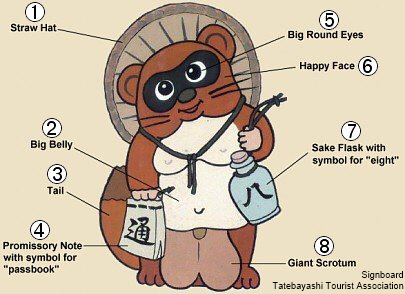
|
|
Modern Explanation
|
Traditional Explanation
|
|
1. Straw Hat (Kasa 笠). The ideogram for umbrella 傘 is also pronounced Kasa. Symbolizes the virtue of readiness (junbi 準備) -- be prepared for bad weather or bad luck falling from the sky; be prepared for unexpected trouble.
|
1. The straw hat is a recent addition, added sometime in the early 20th century (sometimes replaced with an umbrella). Likely derived from an Edo-era song about a tanuki procuring sake on rainy nights. Details here.
|
|
2. Big Belly (Daifuku 大腹, Hara 腹). Symbolizes the virtue of level-headedness (reisei 冷静), composure, confidence, and boldness (daitan 大胆)
|
2. Tanuki’s big belly appeared in artwork by the 18th century; in legends, the Tanuki beats his belly drum on moonlight nights to lead people astray. Details here.
|
|
3. Tail (O 尾). Symbolizes steady and upright efforts, unflinching determination and perseverance; to follow through with resolve until attaining one's goal, to cast aside self-interest (Shiyoku o suteru 私欲を捨てる).
|
3. No significance in Tanuki tales. However, in old fox lore from China, the fox strikes fire out of his tail, or balances a magical jewel atop the tip of his tail.
|
|
4. Promissory Note or Passbook (Tsū 通 or Okayoi). Symbolizes sincerity, honesty, and truthfulness (seijitsu no kokoro 誠実の心); gaining the trust and confidence of others.
|
4. Both the fox and tanuki can cast powerful illusions -- they can turn pebbles and dirt into fake gold and silver or horse excrement into a delicious-looking dinner. Details here.
|
|
5. Big Round Eyes (Marui Me 丸い目). Symbolizes discernment, awareness, looking around, and making good judgments based on proper understanding (mikiwame 見極め). Today round eyes are considered cute, and appear often in anime & manga. See Carl Cassegard for notes.
|
5. No significance. In premodern artwork, round eyes were often used for supernatural beings (demons, dragons) to suggest something terrifying, but today round eyes are considered cute, a sign of a likable, harmless character. Premodern Tanuki masks had slanted eyes.
|
|
6. Happy Smiling Face (Kao 顔). Symbolizes graciousness, kindness, and welcoming attitude (egao 笑顔); also means amiable, good-natured (aisōyoku 愛想良く).
|
6. No significance in Tanuki tales or premodern artwork. In some Edo-period tales, the Tanuki appeared as a terrifying one-eyed spook. By the 19th century, Tanuki is portrayed comically in woodblock prints featuring his big scrotum.
|
|
7. Sake Flask (Tokkuri 徳利). Symbolizes gratitude, thankfulness, and appreciation (kansha 感謝) for one's daily food, and also the merits of eating/drinking in moderation (hara hachibu de 腹八分で) to ensure a long life; also symbolizes the pursuit of a virtuous, principled, and honorable life style (nintoku 人徳).
|
7. Tanuki’s love of sake is commonly traced back to a stanza from a popular old children's song in the Osaka and Kyoto sake-brewing areas (circa 17th century), in which a small tanuki steals sake from brewers on rainy nights. Details here. The ideogram for eight (hachi 八) on the sake flask is the trusted emblem of the Tokugawa Family. Details here.
|
|
8. Giant Scrotum (kinbukuro 金袋). Kinbukuro literally means "gold bag or sack." Symbolizes the promise of expanding weath or having luck with money (kin-un ga yoi 金運が良い).
|
8. A popular theme in Tanuki artwork since the 19th century, meant to symbolize “expanding” wealth. It has nothing to do with sexual indulgences. Details here.
|
|
 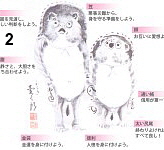 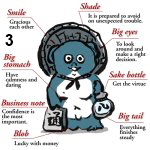 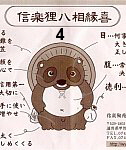
Sources:
(1) Tatebayashi Tourist Association, (2) Shigaraki-Labo Online Shop, (3) Shigaraki Tourist Association,
(4) Tanuki Mura (Tanuki Village) Shopping Zone, (Others) Shinwa Musen Company
NOTE: Early art generally showed the tanuki with pointy ears, but with the beast's commercialization over time, the ears were rounded, probably to make Tanuki less devious, less harmful, and more cute -- just like most of tanuki's other attributes.
|
|
|
|
|
 |
|
|
|
|
|
Popular Tales of Tanuki in Japan
Bunbuku Chagama 文福茶釜・分福茶釜, Lucky Tea Kettle Story
|
|
|
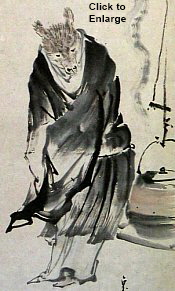
Bunbuku Chagama 分福茶釜 by Katsushika Hokusai 葛飾北斎 (1760 to 1849). Dated to 1794-1804, when Hokusai was named Sōri Tawaraya 宗理俵屋. Photo J-site
|
|
 This extremely popular tale may have emerged in the 16th or 17th century, but in extant artwork it does not appear until the 18th century. It comes in many versions, and initially featured a shapeshifting Fox, not a Tanuki ( read historical references to this storyREFERENCES:
BELOW QUOTE FROM: Bathgate, Michael. The Fox's Craft in Japanese Religion and Folklore: Shapeshifters, Transformations, and Duplicities. Ed. Reynolds, Frank and Winnifred Fallers Sullivan, New York: Routledge, 2003, 190 pages.
During the Edo period (1603-1867), the repertoires of popular printing houses and professional raconteurs (rakugoka) alike regularly featured a story that would later be collected by the folklorist Seki Keigo under the title of "The Lucky Tea Kettle" (bunbuku chagama ). It tells of a fox saved from certain death by the mercy of a human being, and the marvelous exploits by which it repays that kindness. Using its shapeshifting powers, the fox assumes a variety of different forms, each of which the man is able to sell for a tidy sum. After each sale, the fox eventually returns to the man, to assume a new form and be sold again.
Each transaction earns the man more than the one before, and he is soon able to take his place among the prosperous elites of village society.1 Even as the man grows ever more wealthy, however, it is the fox who pays the price. In the episode from which the tale takes its name, for example, the fox assumes the form of a teakettle, in order to be sold to a local priest. Not realizing the true nature of his new acquisition, the priest places the fox-kettle over a fire. Badly burned, the fox reverts to its original form and races away, yelping in pain. In another episode, the fox assumes the form of a horse, a handsome animal that is sold to a nearby feudal lord. Once again, the buyer uses his purchase in a fashion appropriate to its outward form, but disastrous for the fox. Unable to bear a human rider like a genuine horse, the fox quickly succumbs to exhaustion and collapses under its load, and is unceremoniously dumped into a muddy ditch at the orders of its angry rider.
In its basic outline, the story of the Lucky Teakettle can be read as part of an enduring theme in Japanese popular literature, of a man who is able to rise above the circumstances of his birth through a combination of good-heartedness, guile and supernatural assistance. The success of the human protagonist in this story, however, is intimately linked to the repeated punishment of the shapeshifter responsible-even as the reader is encouraged to view the wealth attained by the human protagonist as a happy ending, the tale remains ambivalent regarding the means by which that wealth was achieved. Indeed, the widespread popularity of this tale, from the Edo period to the modern era, might be attributed precisely to this basic sense of ambivalence, an attitude that reflects the changing nature of wealth and society during that time. In this context, the story of 1. Seki (1953, 2:1081-1100) records 42 variants of the tale in folklore from across Japan. Most variants describe the shapeshifter as a fox, although a few portray it as a tanuki or even a cat.
FOOTNOTE. Seki (1963:106) notes that the tale continues to be a prominent theme in children's literature, a fact which has no doubt played an important part in making it what Ikeda (1971:81) describes as one of the best known folk tales in modem Japan. Seki follows his predecessor Yanagita Kunio (1986:69-70) in categorizing the tale as a subtype of the larger theme in which an animal repays a kindness to a human being, though-as I will argue here-it is less the kindness itself than the way in which that kindness is expressed that lends the story its significance as well as its popularity in the pre- and early modern periods. (end quote) ). In one popular variant, a poor woodsman saves the life of a Tanuki. In thanks, the Tanuki transforms itself into a chagama (tea kettle) that the poor man sells to the priest of Morinji Temple 茂林寺 (in the town of Tatebayashi, Gunma, near Tokyo). The priest takes it back to his temple, where he orders his staff to clean it and make some tea. As you might imagine, the Tanuki was very unhappy with his role as a cooking utensil, for it hurt to be polished and used on the fire. After a time, the Tanuki escapes the temple and returns to the woodsman, and thereafter makes money for the woodsman by dancing as a kettle on a tightrope. In another version, a priest tries to catch a Tanuki to eat for dinner, but the Tanuki escapes by changing itself into a tea kettle, which the priest takes back to the temple. But when the priest places the kettle on the fire to make some tea, the kettle sprouts limbs and soon resumes its true Tanuki form. In other versions, the Tanuki transforms into a teapot that never runs out of tea, thereby becoming the favorite of the temple monk, but the Tanuki eventually makes his escape. In the 1994 hit movie Heisei Tanuki Gassen Ponpoko, the chagama is the black round thing the Tanuki children are trying to change into when they are training. Morinji Temple claims the Bunbuku Chagama story originated in the late 16th century, but the earliest extant artwork of the theme (to my knowledge) is a drawing of a mujina making tea in the 1781 Konjaku Gazuzoku Hyakki ( Continued Illustrations of Many Demons Past and Present); see photo here. Curiously, in his lengthy 1908 article on fox-tanuki lore in China and Japan, M.W. De Visser says nothing whatsoever about this legend.
|
|
click to enlarge
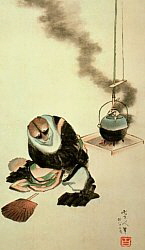
|
click to enlarge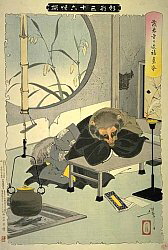
|
click to enlarge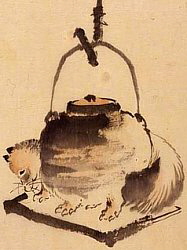
|
|
Bunbuku Chagama 狸狐図, by Katsushika Hokusai 葛飾北斎 (1760 to 1849). Painted in the last year of his life. Source Tokyo Nat’l Museum.
Also this J-site
|
Lucky Tea Pot of Morinji Temple. Here Tanuki assumes his animal form. By Yoshitoshi Tsukioka 月岡芳年 (1839-1892) from New Forms of 36 Apparitions. Photo this J-site.
|
Tanuki transforming into (or out of) the shape of a chagama 茶釜 (tea kettle). Artist unknown, but attributed to the Katsushika Hokusai School , c. 1840s. Photo Library of Congress.
|
|
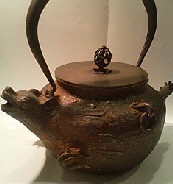
|
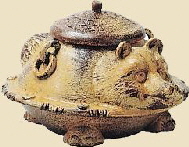
|
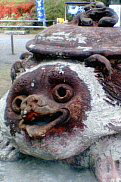
|
|
Iron Tanuki Kettle
(Tanuki Tetsubin 狸鉄瓶).
Meiji Era. Sold at Kyoto-based shop called 難波美術道具店.
See links 1 & 2
|
Tea Kettle Tanuki
Modern Ceramic from Shigaraki.
Available for online
purchase at this J-store.
|
Bunbuku Chagama Tanuki
20th century, ceramic, located at
Morinji Temple, but photo from
Japanese web. Click the image
for photo montage and sources.
|
|
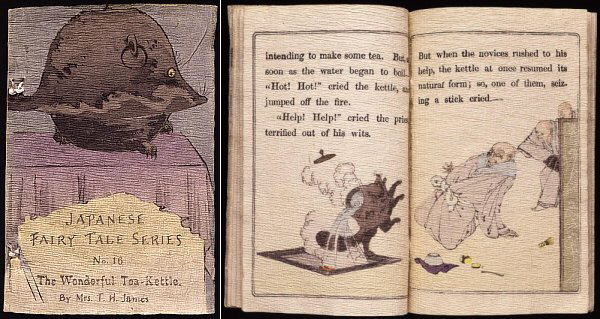
The Wonderful Tea Kettle (title page). English text by Mrs. Thomas H. (Kate) James.
Tokyo: Hasegawa Takejiro, ca. 1896. Woodblock book, printed on crepe paper, 8 in. x 5 in.
Source: Library of Congress. See Rare Book and Special Collections Division.
|
|
|
|
|
|
 |
|
|
|
|
|
Popular Tales of Tanuki in Japan
Kachi-Kachi Yama かちかち山, The Crackling Mountain Story
|
|
A widely circulated legend thought to have originated sometime in the late 16th century or soon thereafter. In the Edo era the tale was also known as The Revenge of the Hare 兎の大手柄. This story comes in many versions, but Tanuki is generally portrayed as an evil creature. In the earliest tales, Tanuki is strung up by a hunter as punishment for eating food set out for the hunter’s pet hare (in other versions, he robs from the field of a farmer). In either case, he is caught. To regain his freedom, Tanuki lies to the hunter’s wife, and once released, he kills her, assumes her shape, and serves her up in a stew to the hunter. Tanuki then taunts the man with the horrible truth. But the hunter, with the help of his rabbit (usagi), avenges her death. In one section of the story, the rabbit and Tanuki are gathering firewood. On the way home, the rabbit tries to set fire to the wood on Tanuki's back. When Tanuki asks the rabbit "What's that sound," the rabbit replies "Don't you know?” Kachi-Kachi is the Japanese word for the sound made when using flint to light a fire. In the final scene, the rabbit and Tanuki are having a boat-racing contest to journey to the moon, but since the Tanuki’s boat was made from clay, it sinks in the middle of the lake, and the Tanuki drowns (in some versions, the rabbit holds an oar atop Tanuki’s head, causing Tanuki to drown). Elsewhere, one of Japan’s main islands (Shikoku 四国) is known as "Tanuki Country" (Tanuki no Kuni 狸の国). The motto of the Shikoku Tanuki Train Line is: "Our ship isn't made of mud." Curiously, in his lengthy 1908 article on fox-tanuki lore in China/Japan, De Visser says nothing about this legend. Also, for various Japanese illustrations of the Kachi Kachi legend, see Prints of Japan.
|
|
click image to read translation
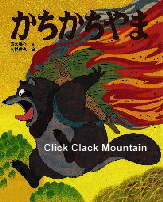
See translation of the story by
Tom Ray and Sachiko Matsubara
at the following J-E site
|
click image to enlarge
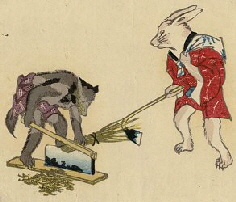
Tanuki and Rabbit. Edo period.
Woodblock print (nishiki-e)
Ink and color on paper.
MFA (Boston) Collection
|
click image to enlarge
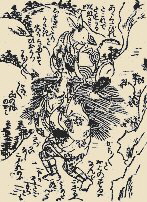
Rabbit sets fire to wood on Tanuki’s back. Edo era. Tōyō Bunko 東洋文庫. Scanned from Illustrated Guide to Japan's Folk Tales (Zusetsu Nihon no Mukashi Banashi 図説日本の昔話), by Ishii Masami 石井正己.
|
|
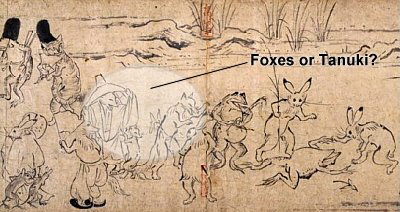
Foxes, Rabbits, Frogs, and Cats in the 12th-century hand scroll known as
Frolicking Animals & Humans (Chōjū Jinbutsu Giga 鳥獣人物戯画). The fox-like
creatures are most probably FOXES -- the Tanuki, if we recall, does not make an
appearance in written Japanese texts until the 13th century (see SIDEBAR). The
Chōjū Jinbutsu is a national treasure owned by Kōzan-ji Temple 高山寺 (Kyoto).
|
SIDEBAR: Tanuki’s earliest appearance in Japanese texts (to my knowledge) is in the 13-century Uji Shūi Monogatari 宇治拾遺物語 and in the Reizei-ke ryū Ise shō 冷泉家流伊勢抄. He also appears in the Nichū Reki 二中暦, a Japanese zodiac calendar from the second half of the 14th century, in which the tanuki, mujna, and fox are listed among the 36 animals of the “Calendar of Animals” (Chikusan Reiki 畜産暦). In this calendar, the mujina, fox and rabbit are combined with the zodiacal sign of the Rabbit, while the tanuki, leopard, and tiger are combined with the zodiacal sign of the Tiger. See Zodiac page for details about the Asian Zodiac. <source De Visser, p. 13>
|
|
|
|
|
|
Popular Tales of Tanuki in Japan
Danzaburō Tanuki, Hage Tanuki, and Shibaemon Tanuki
|
|
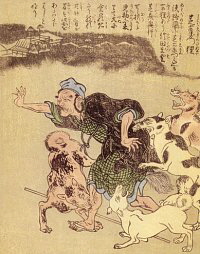
Shibaemon Tanuki
Ehon Hyaku Monogatari 絵本百物語
(Picture Book of 100 Stories), Vol. 3,
by Takehara Shunsen 竹原春泉, circa 1841. Photo here or see entire book

Spinning-top toy in shape of Tanuki
(Hiko-Ichi 彦一独楽 from Kumamoto).
See Gabi Greve for details.
|
|
 In Japan’s Edo-era tales, the Tanuki is commonly given a name. Three of the most widely known are: In Japan’s Edo-era tales, the Tanuki is commonly given a name. Three of the most widely known are:
- Danzaburō Tanuki / Danuki 団三郎狸. He is the head of all Tanuki on Sado Island 佐渡 and credited with ridding the island of all foxes. There are numerous tales. In one, Danzaburo lent money to many people, but many failed to pay him back, so Danzaburo stopped lending. <this story appeared in the Enseki Zasshi 燕石雑志 by Kyokutei Bakin 曲亭馬琴 (1767-1848); see De Visser, p. 85 for English overview>. He is also held responsible for mirages at Futatsu-iwa 二つ岩 in Aikawa 相川 (Sado Island).
- Hage Tanuki / Danuki 禿狸 from Yashima 屋島 (northeast Shikoku). He is also known as Tasaburō Tanuki 太三郎狸, Yashima no Hage 屋島の禿, or Yashima no Kamuro 屋島の禿. He was deceived by Shibaemon Tanuki and lost his life (read story in Yanagita Kunio's Japanese Folk Tales, pp. 34-35), but the people of old Awa Province 阿波国 (present-day Tokushima Prefecture, Shikoku) say he is still alive. Hage Tanuki also appeared in the popular 1994 hit movie Heisei Tanuki. For various earlier tales, see Stories of Tanuki in Awa Province (Awa no Tanuki no Hanashi 阿波の狸の話), by Kasai Shin'ya 笠井新也. First published in 1927 (Chūkōbunko 中公文庫). Modern-day reprints available at Kinokuniya Bookweb.
- Shibaemon Tanuki / Danuki 芝右衛門狸 of Awaji Island 淡路島, near Shikoku and Osaka. Shibaemon appears in numerous tales. In one, he tricks Hage Tanuki of Shikoku, causing Hage’s death (read story in Yanagita Kunio's Japanese Folk Tales, pp. 34-35). Shibaemon is also well known in Osaka, where he reportedly loved to watch kabuki 歌舞伎 (aka 芝居 shibai) at the famous Nakaza Theater 中座. One day it was noticed that the money-collection box contained leaves. A search was conducted, Shibaemon was apprehended, and then killed. But in the days and months that followed, theater attendance fell precipitously. People said it was the curse of Shibaemon, and thereafter, people began to journey to Mt. Mikuma (Mikuma Yama 三熊山) -- Shibaemon’s birthplace, Awaji Island, Sumoto City, Hyōgo Prefecture -- to apologize to Shibaemon and ask for his forgiveness.
- Shibaemon Tanuki, The Fish With No Eyes (this J-site; now defunct). Translated into English by Kazuko Tani. “In the olden days, it was a great effort to carry fish from Kushimoto to Osaka. The most difficult part of the journey was the waters of Shionomisaki and Hinomisaki as the Japanese ships’ sails were blown about by the strong east winds. In every cape, there lives a tanuki. The Misaki tanuki always seemed to board the ships and create mischief. By the time these ships arrive in Osaka, there are no longer any fish aboard. The chief offender was a tanuki called Awaji no Shibaemon. One year the old fishermen had a large amount of fish to take to sell at Osaka. They passed the most dangerous waters and when they got to the more quiet waters of Osaka, they all fell asleep. One of the old fishermen had a feeling that the naughty Shibaemon would come out that night and so stayed up and steered the ship. The old man thought ’There's only a little while 'til Osaka.’ He went to check the cargo of fish. He noticed that all the fish had their eyes missing. He called for everyone to come. They caught the naughty tanuki. ’You are a nasty little tanuki’ they scolded, ’don't do this kind of bad thing.’ Shibaemon said ’I'm sorry, if you'll forgive me I will make you lots of money.’ In Osaka there was a contagious-skin-disease epidemic going on. Shibaemon ran to Osaka town early and cried out, ‘Fish with no eyes are the best medicine for this disease.’ And so all the fish on the boat were sold for three times the price. All the old fishermen came back to Kushimoto as rich men. Shibaemon stopped his bad little antics and became a good little tanuki.” <end quote>
- For more Tanuki tales, see the various sites of Gabi Greve:
|
|
|
|
 |
|
|
|
|
|
Modern Movie of Tanuki in Japan
Heisei Tanuki Gassen Ponpoko 平成狸合戦ぽんぽこ
|
|
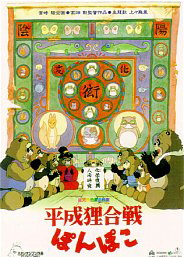
Movie Poster from movie directed by Isao Takahata. “Heisei” is the name of the era of the current Japanese emperor (Akihito). ”Ponpoko” is the sound made by
a Tanuki beating its belly drum.
|
|
 English Name = Pon Poko. A popular movie in both the East & West, released in 1994, written and directed by Isao Takahata 高畑勲 (born 1935) and animated by Studio Ghibli -- the latter is associated with famed film director and animator Hayao Miyazaki 宮崎駿 (born 1941). English Name = Pon Poko. A popular movie in both the East & West, released in 1994, written and directed by Isao Takahata 高畑勲 (born 1935) and animated by Studio Ghibli -- the latter is associated with famed film director and animator Hayao Miyazaki 宮崎駿 (born 1941).
STORY: Tanuki community is driven away from natural mountain habitat by humans, who are developing the area into a gigantic residential site. The Tanuki therefore go to battle against the humans. The movie includes a Tanuki named “Kincho,” who is apparently very famous in Kagawa, Shikoku. Another popular movie character is named Hage-Tanuki (see above). Looking rather befuddled, Hage-Tanuki gathers together the non-transforming Tanuki, and all at once becomes the founder of a dancing and chanting Amida religion.
SONG AND LYRICS: Includes the popular song “Shōjōji no Tanuki Bayashi 証城寺の狸囃子” (lit. = Tanuki Dancing at Shōjōji Temple), in which the Tanuki beats its tummy, singing a song, having fun under the moon. The refrain of the song says "Ponpoko Pon Pon.” This is the sound made by Tanuki beating its tummy. ポンポコ、ポン、ポン. |
|
Song = Shōjōji no Tanuki Bayashi 証城寺の狸囃子, lit. = Tanuki Dancing at Shōjōji Temple.
Song by Nakayama Shinpei 中山晋平 (1887-1952). Lyrics by Noguchi Ujō 野口雨情 (1882-1945).
|
|
証 証 証城寺
証城寺の庭は
ツ ツ 月夜だ
みんな出て 来い来い来い
おい等(ら)の友達ァ
ぽんぽこ ぽんの ぽん
負けるな 負けるな
和尚(おしょう)さんに 負けるな
来い 来い 来い
来い 来い 来い
みんな出て 来い来い来い
証 証 証城寺
証城寺の萩(はぎ)は
ツ ツ 月夜に 花盛り
おい等(ら)は浮かれて
ぽんぽこ ぽんの ぽん
(sound of belly drum)
|
Shō shō Shōjōji
Shōjōji no niwa wa
Tsu tsu tsukiyo da
Minna dete koi koi koi
Oira no tomodacha
Pon poko pon no pon
Makeruna makeruna
Osho-san ni makeruna
Koi koi koi
Koi koi koi
Minna dete koi koi koi
Shō shō Shōjōji
Shōjōji no hagi wa
Tsu tsu tsukiyo ni hana zakari
Oira wa ukarete
Pon poko pon no pon
(sound of belly drum)
|
At Shōjōji Temple
In the temple garden
In the moonlight
Come on everybody
My friends play belly drums
Pon poko pon no pon
Don't lose your dancing bout
Against the monk
Come here
Come here
Everybody come here and dance
At Shōjōji Temple
The temple’s bush clover
Is in full bloom under the moon
I’m in a festive mood
Pon poko pon no pon
(sound of belly drum)
|
|
LEARN MORE ABOUT THE FILM (outside sites)
|
|
|
|
|
|
|
|
 |
|
|
|
SHIGARAKI CERAMICS & TANUKI
|
|
Says pottery expert Robert Yellin: “The Tanuki is synonymous with modern-day Shigaraki 信楽 (Shiga Prefecture 滋賀県). Shigaraki-style pottery, which traces its origins back to the 12th century, is one of Japan’s most beloved ceramic styles. But the Shigaraki staple most folks are familiar with today is not Shigaraki tsubo 壷 (large ceramic jars), but rather the pudgy ceramic Tanuki that stands in front of drinking establishments throughout Japan. It holds a sake flask in one hand and in the other, a promissory note for the booze; it never pays, though. If you've ever been to Shigaraki, you cannot miss the numbing variety of garish tanuki that stand in front of many tourist shops.” <end quote>
Writes Alice Gordenker in the 15 July 2008 Japan Times: “Most tanuki statues are Shigaraki-yaki, a type of ceramic ware made in and around the town of Koga 甲賀市 in Shiga Prefecture. According to the association of local pottery manufacturers, the now familiar design of a cheerful, slightly goofy-looking tanuki, often carrying a flask of sake, was developed by Fujiwara Tetsuzō 藤原銕造 (1876-1966), a potter who moved to the area in 1936 and devoted the rest of his career to tanuki statuary. In 1951, on the occasion of an imperial visit, the town prepared a special row of flag-waving tanuki statues. Emperor Hirohito was so charmed by this welcome that he penned a poem about it. That was a story the media couldn't resist, and the resulting publicity contributed greatly to the popularity of the statues. The most common place to see a tanuki statue is in front of restaurants and shops, where they're placed to lend some traditional atmosphere and invite success in business (shōbai hanjō 商売繁盛). <end quote>
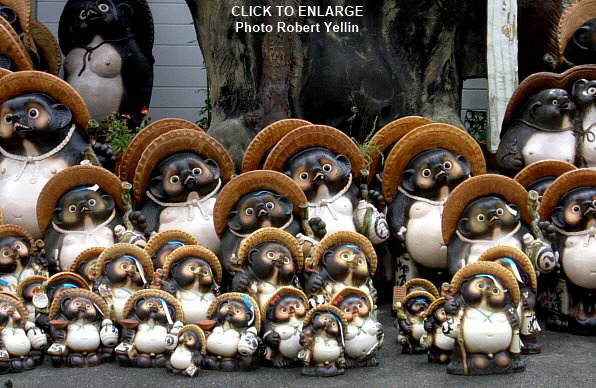
Statues of the Magical Tanuki are synonymous with modern-day Shigaraki (Shiga Pref). Photo by Robert Yellin.
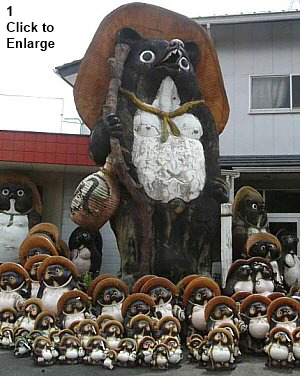 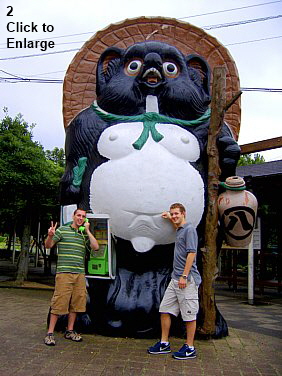
1. Tanuki statues are a common sight in Shigaraki. Photo courtesy Robert Yellin.
2. Tanuki Pubic Telephone just outside Shigaraki Station. Photo courtesy Baron Knoxburry.
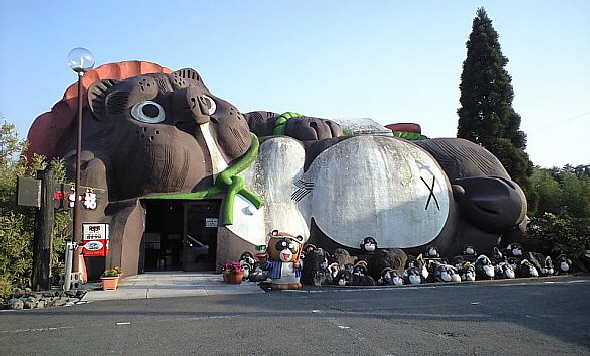
Bunbuku Store -- arts and crafts store in Shigaraki in the shape of Tanuki.
|
|
|
|
 |
|
|
|
|
BADGER 獾 (Chn. = huān; Jp. = anaguma)
|
|

Manjū Kisaemon Tanuki
まんじゅうの喜左衛門狸
Kisaemon Tanuki is a brand character for a Shikoku-made manjū 饅頭 (a bun typically filled with red bean paste). Here Tanuki is shown wearing a red robe decorated with the Chinese symbol 囍, which means “double happiness.” In China, this symbol is associated with the badger. See text at right for more details. Incidentally, the island of Shikoku 四国 is known as Tanuki Country 狸王国 owing to its numerous Tanuki legends, including one involving a Tanuki named Kisaemon. Photo this J-site. Also see Kisaemon Tanuki entry from the International Research Center for Japanese Studies, Kyoto.

Real-life Badger
Photo this J-site
|
The badger does not figure prominently in Japanese or Chinese folklore or artwork -- yet Western scholars have mistranslated Tanuki / Mujina as “badger” or “raccoon-dog” for decades, and this has caused great confusion among folklore enthusiasts. In general, we can say that all animals in China, even the smallest, may be shape-shifters, but only some of them are preeminent in folklore and artwork -- and the badger is NOT one of them. Let me say it again. The "badger" is a mistranslation of Tanuki / Mujina, for the real-life badger and mythological badger exerted no major impact on Japan's Tanuki lore or Mujina lore. Indeed, the badger 貛 (Chn. = Huān, Jp. = Kan) rarely appears in Chinese or Japanese mythology. When it does, it most often symbolizes good fortune and happiness.
Writes Patricia Bjaaland Welch in Chinese Art: A Guide to Motifs and Visual Imagery (page 111, Tuttle Publishing, 2008): “The homophone huān in Chinese means both badger 獾 and happiness 欢, hence a pair (shuāng 双) of badgers in Chinese art represents double happiness (shuāngxi 囍), the Chinese symbol of conjugal bliss. Raymond Li has a charming agate carving of two entwined badgers in his snuff bottle collection (depicted together with two peanuts, which represent fertility). Badgers are usually combined with magpies, which are associated with impending good fortune or happiness in a pattern known as huāntiān-xǐdì, 欢天喜地, usually translated as 'boundless joy' (literally 'happiness on heaven and earth'). <end quote>
囍
Translated as Double Joy or Double Happiness; pronounced “shuāngxi” in Chinese; used commonly as a decoration. It is a ligature composed by writing the character for joy -- 喜 -- two times, hence 囍. Note: In Chinese, the term xǐ huān 喜歓 means “to like something,“ while huān xǐ 歓喜 means “to make one happy.”
|
|
|
|
|
 |
|
|
|
Primary Resources All web pages last accessed on Oct. 2, 2011
|
-
|

Tanuki and Moon (scroll)
Date 1930s/40s.
Artist = Shundo
Photo from Ohmi Gallery
Ross Walker Collection)
Photo this J-Site.
|
|
 Asahi.com, Yakimono (Ceramics) Guide Asahi.com, Yakimono (Ceramics) Guide
- Association of Shigaraki Ceramic Companies
- Butsuzō zui 仏像図彙 (Illustrated Compendium of Buddhist Images). Published in 1690 (Genroku 元禄 3). A major Japanese dictionary of Buddhist iconography. Hundreds of black-and-white drawings, with deities classified into categories based on function and attributes. For an extant copy from 1690, visit the Tokyo Metropolitan Central Library. An expanded version, known as the Zōho Shoshū Butsuzō-zui 増補諸宗仏像図彙 (Enlarged Edition Encompassing Various Sects of the Illustrated Compendium of Buddhist Images), was published in 1783. View a digitized version (1796 reprint of the 1783 edition) at the Ehime University Library. Modern-day reprints of the expanded 1886 Meiji-era version, with commentary by Ito Takemi (b. 1927), are also available at this online store (J-site). In addition, see Buddhist Iconography in the Butsuzō-zui of Hidenobu (1783 enlarged version), translated into English by Anita Khanna, Jawaharlal Nehru University, New Delhi, 2010.
- Imaizumi Tada-aki. Korigaku nyūmon: kitsune to tanuki wa naze hito o bakasu? Tokyo: Kodansha. 1994. 狐狸学入門―キツネとタヌキはなぜ人を化かす? (lit. = Intro to the Fox and Tanuki: Why do they take human form?)
- International Research Center for Japanese Studies in Kyoto (J-site) , Monster Database, 国際日本文化研究センター | 怪異・妖怪伝承データベース. Also see their homepage.
- Kasai Shin'ya 笠井新也, Stories of Tanuki in Awa Provice (Awa no Tanuki no Hanashi 阿波の狸の話). 1927. Modern reprints from Chūkōbunko 中公文庫 available at Kinokuniya Bookweb.
- Kinmōzui 訓蒙図彙 or 訓蒙圖彙 (Collected Illustrations to Instruct the Unenlightened), a Japanese work compiled in 1666 by Nakamura Tekisai 中村惕斎 (1629-1702) and considered Japan's first illustrated encyclopedia. The Kinmōzui was expanded in two sequels, one in 1695 (Kashiragakizōho Kinmōzui 頭書増補訓蒙圖彙) and another in 1789 (Kashiragakizōho Kinmōzui Taisei 頭書増補訓蒙圖彙大成). It was created in the same vein as the earlier encyclopedic Sāncáitúhuì (San Ts'ai T'u Hui) 三才圖會 (Illustrated Compendium of Heaven, Earth, and Humanity), a Chinese document dated to 1610. See digitized 1789 Kinmōzui at the Kyūshū Univ. Museum Digital Archive (or jump to their entrance page. See too Iwase Bunko Library 西尾市岩瀬文庫 or this J-site.
- Kyūshū University Museum Digital Archive, Wakan Top || V 38
- Morinji Temple 茂林寺 (Tatebayashi, Gunma); its Bunbuku Chagama legend; see its Tanuki statuary at J-Site #1 & J-Site #2.
- Muian.com. A wonderful online database of Edo-era ukiyo-e prints.
- Nakamura Teiri 中村禎里, Tanuki to Sono Sekai 狸とその世界 (The Tanuki and Its World), Asahi Shinbunsha 朝日選書, 1990. Also see Amazon Books.
- National Diet Library, Kindai Digital Library, Wakan Sansai-zue
Vol. 1-36 || Vol. 37-71 || Vol. 72-105
- Nihon Shoki 日本書紀 (aka Nihongi or Chronicles of Japan, circa 720 AD). In the Suiko Tenno 推古天皇 section (Chapter 22, Paragraph 1, Page 1335) it says: “35th year, Spring, 2nd month. In the province of Michinoku, there was a mujina which changed into a man and sang.” 三十五年。春二月。陸奥國有狢。化人以歌之. In the Suinin Tenno 垂仁天皇 section (Chapter 6, Paragraph 3, Page 443) it says: “Formerly in the Land of Tamba, in the village of Kuwada, there was a man whose name was Mikaso. Now, in Mikaso's house there was a dog, by name Ayuki. This dog bit a wild animal called the mujina and killed it. In the animal's belly there was found a magatama of Yasaka gem. This gem was accordingly offered to the Emperor. It is now in the shrine of Iso no kami.” 昔丹波国桑田村有人。名曰甕襲則甕襲家有犬。名曰足往。 是犬咋山獣名牟士那。而殺之。則獣腹有八尺瓊勾玉。因以献之。是玉今有石上神宮。 <Note: Mujina spelled phonetically as 牟士那> Search the Nihon Shoki online at the Japanese Historical Text Initiative, University of California at Berkeley. Main Page // Advanced Search // Gateway to All Texts // Page Scan, Chapter 6.
- Ōwaku Shigeo 大和久重雄, Hagane no Chishiki (Knowledge about Steel) 鋼の知識 (Diamond Shakan ダイヤモンド社, 1971)
- Reizei-ke ryū Ise shō 冷泉家流伊勢抄; 13th-century annotations to The Tales of Ise. Episode 63 mentions that "wolves, foxes, and tanuki that live for more than one hundred years have both the power to change their shapes and the will to harm humans." Quoted from Noriko T. Reider's 2009 article in the Japanese Journal of Religious Studies.
- Sansai-zue (San-ts'ai t'u-hui) 三才圖會, Chinese text, by Wang Qi 王圻, 1610. Also see the Tokyo Metropolitan Library.
- Sankai Ibutsu 山海異物 (Mythical Creatures of the Mountains and Seas, two volumes). The Sankai Ibutsu is an early 17th-century illustrated Japanese book now in the Spencer Collection of the New York Public Library. See article by Masako Nakagawa (Villanova University) in Sino-Japanese Studies, Volume 11. This article provides no information about Tanuki. This nonetheless helps in dating the creature’s probable appearance in Japanese artwork. Also see this J-site devoted to the Sankai Ibutsu. It mentions Tanuki here: Page 1 || Page 2. Also see this E-site of Chinese animals.
- Seki Keigo 関敬吾 (1899-1990), ed. 1953. Nihon Mukashibanashi Shūsei 日本昔話集成. Six Volumes. Kadokawa Shoten, Tokyo, V2, pp. 1081-1100).
- Shigaraki Ceramic Cultural Park (SCCP)
- Shikitei Sanba (Samba) 式亭三馬 (1776-1822), Hara Tsuzumi Tanuki Tadanobu 腹鼓狸忠信 (True Stories of the Belly-Drumming Tanuki), University of Tokyo Digital Archives. Shikitei was a well-known writer of Kokkeibon 滑稽本 (humorous books), e.g. Ukiyoburo 浮世風呂 (The World at the Bath-House; 1809-13) and Ukiyodoko 浮世床 (The World at the Barber Shop; 1813-14).
- Takotubo (modern day artwork of Japan's traditional monsters).
- Tanuki Books (J-site). Provides listing for various books.
- Tanuki Lore in Shikoku (known as “Tanuki Country”). 狸伝説. J-site.
- Tanuki Mura Shopping Village (J-site).
- Toriyama Sekien 鳥山石燕 (1712-1788). See images from the 1776 Gazu Hyakkiyakō 画図百鬼夜行 (Illustrated Night Parade of 100 Demons), the 1781 Konjaku Gazuzoku Hyakki 今昔画図続百鬼 (Continued Illustrations of Many Demons Past and Present), and the 1784 Hyakki Tsurezure Bukuro 百器徒然袋 (Idle Collection Bag of Many Things).
- Tsukioka Yoshitoshi 月岡芳年 (1839-1892), New Forms of 36 Apparitions (Shinken Sanjyuroku Kaisen 新形三十六怪撰).
- Uji Shūi Monogatari 宇治拾遺物語, a 13th or 14th century Japanese text, wherein a tanuki shape-changes into Fugen Bosatsu but is eventually discovered and killed.
- Wakan Sansai-zue 和漢三才図会 (Illustrated Sino-Japanese Compendium of Heaven, Earth, and Humanity), a 105-volume Japanese encyclopedia completed around 1712 - 1715 AD, attributed to Terajima Ryōan 寺島良安. Kyūshū University Museum Digital Archive. Wakan Entrance Page || Vol. 38. Also see Apple - Nagano Institute of Radio Wave Technology.
- Waseda University Digital Library. To jump to their entrance page (English), click here.
- Yanagita Kunio 柳田國男 (1875-1962). Japanese Folk Tales (Nippon no Mukashibanashi 日本の昔話), 1942, Published by Mikuni Shobō 三国書房 (Tokyo). Translated into English by Fanny Hagin Mayer, Tokyo 1954. Read English translation at scribd.com.
- Zokutō Ritsu 賊盗律 (Laws Concerning Robbers), written in 702 by Fujiwara no Fuhito 藤原不比等. Section VII of the Laws contain warnings against "smoking foxes & badgers out of graves.”
- Zusetsu Edo Tōkyō Kaii Hyaku Monogatari 図説江戸東京怪異百物語 (100 Strange Tales of Edo Tokyo), an illustrated Japanese text by Kōichi Yumoto 湯本豪一; published 2007 by Kawade Shobō Shinsha 河出書房新社 (Tokyo). A collection of Edo-era tales and Meiji-era newspaper stories about strange and mysterious happenings. For English translations of five Tanuki tales from this work, see Zack Davisson’s Hyakumonogatari.
|
|
Secondary Resources All web pages last accessed on Oct. 2, 2011
|
-
 Ball, Katherine M. Animal Motifs in Asian Art: An Illustrated Guide to Their Meanings and Aesthetics. Courier Dover Publications, 2004. First published 1927. The badger (i.e., Tanuki) is discussed on pages 141 - 146. Curiously, Ball (an avid collector of Japanese art and a founding member of the Japan Society) borrows heavily from the research and writings of De Visser (see below), but gives no credit to De Visser. Ball, Katherine M. Animal Motifs in Asian Art: An Illustrated Guide to Their Meanings and Aesthetics. Courier Dover Publications, 2004. First published 1927. The badger (i.e., Tanuki) is discussed on pages 141 - 146. Curiously, Ball (an avid collector of Japanese art and a founding member of the Japan Society) borrows heavily from the research and writings of De Visser (see below), but gives no credit to De Visser.
- Bathgate, Michael. The Fox's Craft in Japanese Religion and Folklore: Shapeshifters, Transformations, and Duplicities, ed. Reynolds, Frank and Winnifred Fallers Sullivan, (New York: Routledge, 2003), 190 pages. Read book at Questia.com.
- Casal, U.A. (1959). The Goblin Fox and Badger and Other Witch Animals of Japan, 93 pages, Asian Folklore Studies, vol. XVIII.
- Davisson, Zack. Translated Japanese Ghost Stories and Tales of the Weird and the Strange. His web site, Hyakumonogatari, includes various Tanuki stories translated from the Zusetsu Edo Tōkyō Kaii Hyaku Monogatari 図説江戸東京怪異百物語 (see entry in Primary Sources above).
- De Groot, J.J.M., Religious System of China, Brill (1892), Reprinted in 2003 by Kessinger Publishing. See Sheu Shen Ki (p. 78) // Kori 狐狸 (p. 191)
- De Visser, M.W. The Fox and the Badger in Japanese Folklore, Transactions of the Asiatic Society of Japan, Vol. XXXV1 (1908).
- Digital Dictionary of Buddhism (user name = guest). Find Buddhist texts referring to Tanuki.
- Foster, Michael Dylan. Pandemonium and Parade: Japanese Monsters and the Culture of Yōkai. English. ISBN-10: 0520253620. Published Nov. 2008.
- Frédéric, Louis. Japan Encyclopedia. Harvard University Press, 2005
- Greve, Gabi. See her Tales of Hiko-Ichi 彦一 from Kumamoto Prefecture; also see Regional Tanuki Lore and Amulets; also see Tanuki Kigo and Haiku.
- Gill, Robin. D. Octopussy, Dry Kidney & Blue Spots - Dirty Themes from 18-19c Japanese Poems, Paraverse Press, 2007. See section entitled Balls Gold & Blue; also see Senki-mochi 疝気持.
- Harada, Violet H. (1976). The Badger in Japanese Folklore. Asian Folklore Studies, V35, pp. 1-6. Nanzan Institute for Religion and Culture. Says Harada in her conclusion: “The badger in Japanese folklore is a complex creature possessing special powers and capable of assuming a hundred shapes. It chants Buddhist sutras and makes merry with its belly-drum. It tricks unwary peasant travelers and devout priests and metes out revenge in its own cruel ways. Sometimes the duped, more often the irrepressible trickster, the badger weaves a unique magic in the oral tradition of Japan.” <end quote>
- Humbert, Aime. Japan and the Japanese. 1874.
- Japan Times, Tanuki, you old toad-eatin' rascal (Mark Brazil), 29 July 1998. Also see Animal Tracker, Racoon Dog (Rowan Hooper), 27 July 2001. Also see Tanuki Genitals (Alice Gordenker), July 15, 2008, and Luck, Trickery and Treasure in Koka City (Perrin Lindelauf), March 8, 2009, and Wild Watch, Japan's Mammalian Riches (Mark Bazil), 15 May 2011. Or view all Japan Times’ Tanuki stories.
- Joly, Henri L., Legends in Japanese Art, 1908, published by John Lane (London) and John Lane Company (New York). Courtesy of the Internet Archive.
- Kennelly, M. Chinese Superstitions. 1914.
- Krappe, Alexander H., Far Eastern Fox Lore, California Folklore Quarterly, 1944.
- KuniyoshiProject.com. Massive collection of digitized prints.
- Museum of Fine Arts Boston. Explore all their Tanuki artwork.
- Obakemono Project - Tanuki Page. Gaijin's Guide to the Fantastic Folk Monsters of Japan.
- Rubin, Norman A, www.asianart.com/articles/rubin/. Tanuki “can, at times, be frightening creatures, and at other moments be capable of making a negative situation positive. Sometimes they are treated as godly figures and become cultural heroes. The ‘tanuki’ is sometimes seen as a witch, a cannibal monk, or a one-eyed demon who murders his victims with thunder, lightning or earthquakes. Sometimes he is depicted humourously, having a gigantic scrotum which he drags behind him or wears it as a kimono. In some Netsuke figures the tanuki appears as a Buddhist monk dressed in robes and banging on his scrotum as if it were a temple drum.”
- Welcome Shikoku. World's largest bronze statue of Tanuki.
- Tanuki Magazine. Japanese Culture Worldwide. By Kathryn Ruth Ortland, 2005. Quotes me.
- Yamasa Institute, Aichi Center for Japanese Studies, Things Japanese - Tanuki. Newsletter, 15 September 2001.
|
|
Tanuki Trivia & Miscellany All web pages last accessed on Oct. 2, 2011
|
-
|
|

Mujina Tsuka 貉塚 - a memorial stone at Kenshōji Temple 見性寺 in Tokyo.
Photo from Pinktentacle.com
|
|
Pinktentacle.com. Phantom Train Sightings. Railroads played a key role in the modernization of Japan. After the first trains started running in 1872, railroads quickly expanded across the country. But as the number of trains increased, so did the frequency of phantom train sightings. These phantom trains, whose sightings have been documented by scholars such as ethnologist Kunio Yanagita and folklorist Kizen Sasaki, were often thought to be the work of shape-shifting animals such as the kitsune (fox), tanuki (fox-like dog) and mujina (fox-like creature), because the carcasses of these animals would often be found near where sightings took place.
- Foxes refuse to be domesticated. A badger (tanuki) makes a pet something like a dog -- it can even be walked on a leash -- but a fox, even raised from birth by humans, never relaxes and hates being touched (Koizuka Minoru. 1982. "Kitsune monogatari." Tokyo: Sanichi Shobō., page 44). The character for "dog," written on the forehead of a child, protects it from foxes (Buchanan D.C. 1935. "Inari: Its Origin, Development, and Nature." Transactions of the Asiatic Society of Japan, page 53). Fish paste smeared over the body of a fox-possessed person and licked off by a dog is so abhorrent that the fox leaves (Koizuka 1982, page 29). Conversely, carrying a fox tooth keeps one safe from dog sorcery (De Visser 1908, page 121). <above quoted from Michael Bathgate’s “The Fox's Craft in Japanese Religion and Folklore: Shapeshifters, Transformations, and Duplicities,” ed. Reynolds, Frank and Winnifred Fallers Sullivan, (New York: Routledge, 2003), 190 pages. Read book at Questia
- Tanuki appear often in Japanese folklore as women. Strangely, this theme is not represented often in artwork -- instead, the Tanuki appear most often in art as fat monks. The role of were-vixen, it seems, is generally reserved for the fox (kitsune). As U.A. Casal (p. 50) says “Kitsune is applied to women who disrupt family life by ensnaring and financially ruining the husband or son....the term badger (tanuki) was given in a patronizing manner to buffoons, jesters, and other male entertainers who by their witty chatter and antics amused and enlivened festive parties. The wily, patient, ‘diplomatic’ Shogun Tokugawa Ieyasu was irreverently nicknamed ’Furu-Tanuki,’ Old Badger. Note that in English ‘to badger’ means to tease, to worry.
- Tanuki are extremely fond of fish, and will steal fish whenever the opportunity arises. The fox, in contrast, loves anything fried, and will steal abura age (fried tofu) and other such items whenever possible. The Tanuki is also fond of parched beans. In many areas he is still called Mameda 豆狸 (small tanuki, lit. “bean tanuki”), for he likes to stuff himself on beans (mame 豆) -- in some stories he eats so many that he gets a tummy ache.
- Like the fox, tanuki can also "emit fire." This is called kitsune-bi 狐火 (fox) or tanuki-bi 狸火 (tanuki) -- both are terms for will-o'-the-wisps or mysterious lights that sometimes lead the unway to disaster. Says U.A. Casal (p. 51): “In the Osaka-Kishū district mainly, there is a belief that tanuki-bi wander around on rainy nights. The unwary rustic mistakes this for the glowing pipe of a fellow farmer; he will not only hold conversation with the disguised tanuki, but may even light his own pipe at this ghost-fire! Since the use of tobacco among the lower classes goes back hardly to the beginning of the 17th century, this shows that the belief in tanuki was strong enough to create new variants as opportunity arose, up to comparatively recent times.” <end quote> Says Norman A. Rubin at asianart.com: “Legends tell of how 'Kitsune' can hypnotize people and lead them into perilous situations. To do this, according to the tales, they illuminate the path leading to such disasters, and this illumination is known as a ’foxflare’ (kitsune bi).”
- Food - Tanuki Soba 狸そば. Tempura batter flakes are sprinkled on the top, and melt into a jellylike sauce. Named after the Tanuki, perhaps because the tempura flakes don’t contain vegetables, fish, or more hearty substances. The batter flakes are just another “illusion” cast by the mischievous Tanuki, for when you bite into the tempura, you don’t get any “substantial” food.
- Tanuki no Kuni 狸の国, lit. = Tanuki Country. Some of Japan’s oldest Tanuki legends hail from Shikoku 四国, which is known locally as “Tanuki’s Country.” Kinchō Tanuki 金長狸 is the name of one legendary Tanuki character.
- "Tanuki," written by the noted historical novelist Osaragi Jirō 大佛次郎 (1897-1973). First presented in 1953, it is a modern sewamono 世話物 comedy (sewamono are contemporary plays that generally focus on commoners and their lives/issues). American author Tom Robbins (b. 1936), in his 2003 novel Villa Incognito, incorporates Tanuki mythology.
- “Because of its pot belly, Tanuki is associated with two other figures with large stomachs, the Fugu (blow fish) and Hotei, the fat God of Luck. The famous Shogun, Ieyasu Tokugawa, was irreverently referred to as Furu Tanuki 古狸 (Old Tanuki).” Quoted from Yamasa Institute, Aichi Center for Japanese Studies, Things Japanese - Tanuki. Newsletter, 15 Sept. 2001. The newsletter also says “'Tanuki-gao 狸顔 (lit. Tanuki face) is sometimes used to describe women with rounded facial features.” Another web site adds that Tanuki kao / gao “refers to women with wide-set eyes, a wide forehead, full lips, and a round shape. Conversely, kitsune kao/gao (or fox face), refers to women who have a narrow face having close-set eyes, thin eyebrows, and high cheekbones.”
- Uhō Dōji 雨宝童子. Says Louis Frédéric in his Japan Encyclopedia (2005 Harvard University Press): “Shintō kami (or gongen), said to have the power to fend off bad luck, perhaps a form of Vairocana (Dainichi Nyorai) or Marīci (Marishi-ten). It is (very rarely) portrayed as a noble with a small pagoda on his head and a white tanuki lying at his feet.” Also see JAANUS.
- Kokkuri 狐犬狸 「こっくり」. Literally “Fox, Dog, and Tanuki.” Kokkuri was an extremely popular mass-culture divination game in the 1880s. Players invoked traditional yōkai (monsters) to divine the future, much as Americans used a Ouija Board. In Pandemonium and Parade: Japanese Monsters and the Culture of Yōkai, author Michael Dylan Foster writes (p. 85): “The setup for Kokkuri was simple: three bamboo rods were tied together to form a tripod, and a round tray or the lid of a wooden rice container was balanced on top. Three or four people would kneel around the table-like structure, placing their hands lightly upon the lid. The game begins with one person chanting ‘Kokkuri-sama, please descend, please descend. Come now, please descend quickly.’ After about ten minutes of this invocation, the person says ‘If you have descended, please tilt towards so-an-so.’ And with the lid balanced in place, the apparatus tilts, the bamboo leg on the other side lifting up...Now any of the three people can ask questions.” <end quote> A variation of the game was still being practiced in the aftermath of WWII, with people invoking the kami Inari (god of rice, whose messenger is the fox). Says my longtime Japanese friend Ando Kagari: “During the hardship years surrounding World War Two, people in the city of Kyoto held seance sessions to invoke the aid of Inari. A Ouiji-like board was made by placing Japanese alphabet cards on the floor. In the center of the cards was an odd contraption -- three chopsticks standing upright, leaning against each other, like a teepee, and inside the three-pronged conjunction at the top was placed an ochoko (drinking cup). Gathered round, those present begin chanting Inari's name. A question is asked (e.g., is my son still alive), more chanting to Inari, and then magic -- the chopstick structure begins to move, spelling out the answer by moving atop the alphabet cards.”
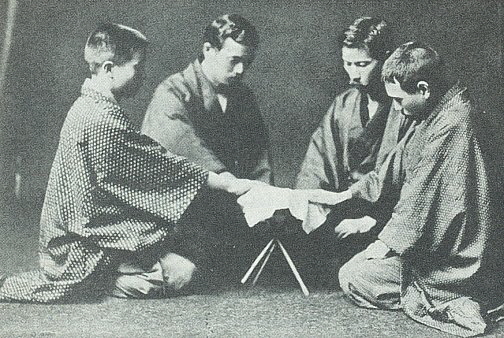
Kokkuri, from a 1912 book on hypnotism by Murakami Tatsugorō 村上辰午郎
entitled Saishinshiki Saiminjutsu 最新式実験催眠術講義. View digitized version at the National Diet Library.
Photo scanned from p. 86 of Michael Dylan Foster’s Pandemonium and Parade, 2008.
- Japanese Aphorism. Toranu tanuki no kawa zanyo 捕らぬ狸の皮算用, literally "Counting tanuki skins before they're caught," i.e., counting your chickens before they're hatched.
- Proverbs: 「タヌキ寝入り」「タヌキ親爺」「捕らぬタヌキの皮算用」「タヌキの金玉は千畳敷」などのことわざがあるし. <Source: Association of Shigaraki Ceramic Companies>
- Tanuki-Related Terms and Names
- Anaguma 穴熊 (badger)
- Arai-guma 洗熊 (racoon, raccoon)
- Bakedanuki 化け狸 (shape-shifting tanuki)
- Bai 霾 (misty, foggy; made up of radical for rain 雨, and the old kanji for tanuki 貍)
- Furudanuki 古狸 (old tanuki, one able to shape shift)
- Iwadanuki 岩狸 (hyrax, a small herbivorous mammal)
- Kan 貛 (badger)
- Kitsune 狐 (fox)
- Kodanuki 小狸 (baby tanuki, small tanuki)
- Kokkuri 狐犬狸 「こっくり」 (literally “fox, dog, and tanuki”); name of divination game
- Kori 狐狸 (lit. foxes and tanuki); an old Chinese ideogram referring simply to foxes but sometimes to both foxes and tanuki. In general, in China, the term specified evil fox spirits. An early reference to 狐狸 can be found in the Sōushénjì 搜神記 (Sheu Shen Ki), a 4th-century Chinese text attributed to Gan Bao 干寶 (fl. 317-322). The term and passage is quoted in Religious Systems of Japan, p. 191, note 1, by Prof. De Groot. But by the 10th century, the tanuki 狸 replaced the fox in various Chinese legends. Thus, for example, writes De Visser, p. 1, note 1: "According to the Tai P'ing Kwang Ki 太平廣記 (by Li Fang 李昉 925-96 and others), there is a legend which tells of a tanuki 狸, a thousand years old, which took the shape of a student and tried to haunt a man called Tung Chung-shu. BAKIN (Bakin Takizawa 1767-1848, author of Enseki Zasshi 燕石雑志) thinks that this is nothing but the old fox tale of the Sheu Shen Ki, dressed up in a new garb.
- Kōri 香狸, Chn. = Xiāng Lí (civet)
- Kyūbin Kitsune 九尾狐 (nine-tailed fox)
- Mamedanuki 豆狸 (a small tanuki); said to steal sake on rainy nights
- Mami 貒・猯 (another name for tanuki / anaguma); mami 魔魅 means "deceiving spirit"
- Midanuki 貒狸 (another name for badger)
- Mujina 貉・狢 (fox-like creature; another name for tanuki); in 8th-century Nihon Shoki (Chronicles of Japan), the mujina appear twice. In once instance, the creature’s name is spelled phonetically as 牟士那.
- Ōkami 狼 (wolf)
- Sai 豺 (mountain dog)
- Tanuki 貍、狸、たぬき、タヌキ (the topic of this web page); the 貍 ideogram appeared in 5th-century Chinese translation of the Brahma Net Sutra 梵網經 T 1484.24.1007b13 and in 8th-century Brahma Net Sutra (Daehyeon) 梵網經古迹記 HBJ 3.469a4; T 1815.40.714a9〕. Like other words for wolf, fox, and wild dogs and cats, it can use either the canine radical 犭or feline radical 豸. In both China and Japan, the modern character for Tanuki 狸 employs the canine radical犭. The archaic character (kyūjitai 旧字体) for Tanuki 貍 employs the feline radical 豸. In China, by the 10th century, ,
- Tanuki Jiru 狸汁 (soup with tanuki meat & vegetables; said to cure piles & running ulcers: can also be made with badger meat, said to be more tasty)
- Ya-byō or Ya-myō 野猫 (field cat, wild cat); Chn. = Yě Māo or Yeh Mao.
- Yūri 狖狸 (weasels and tanuki); term appeared in 3rd-century Chinese translation of the Lotus Sutra 正法華經 T 263.9.76b28.
- Tanuki in Japanese Media 映画の中の神話・伝承キャラクターの辞典 <source this J-site>
- 『歌ふ狸御殿』1942演/高山廣子、宮城千賀子、美ち奴、その他
- 『まんが日本昔ばなし』 TV (『カチカチ山』1975『しょじょ寺の狸ばやし』
1976『たぬきの糸車』1976)声/?
- 『ゲゲゲの鬼太郎』1985-1988 TV. 声(タヌキ軍団)/柴田秀勝(刑部狸)
千葉繁(シルクハット)西尾徳(団十郎狸)大塚芳忠(飛脚狸)大塚芳忠(部下狸)
- 『カッパの三平』1993声/井上遥(黒麿) 原/水木しげる
- 『平成狸合戦ぽんぽこ』1994. 声/泉谷しげる(権太)三木のり平(青左衛門)
黒田由美(小春)神谷明(玉三郎)山下容莉枝(お玉)その他
- 『ゲゲゲの鬼太郎』1996-1998 TV声/?(八百八狸)
- 『オペレッタ狸御殿』2005演/チャン・ツーイー(狸姫)薬師丸ひろ子(お萩の局)
パパイヤ鈴木(次郎狸)真田幹也(侍狸)高橋元太郎(家老狸)南州太郎(御殿医狸)
石川伸一郎(団三郎狸)大葉ふゆ(給仕女狸)山崎樹範(狸奴)その他多数
- 『やじきた道中 てれすこ』2007演/?
- 『ゲゲゲの鬼太郎 千年呪い歌』2008(実写)演/ブラザートム、星野亜希(竹切り狸)
- 『豆富小僧』2011声/宮迫博之、はるな愛 原:京極夏彦
|
|
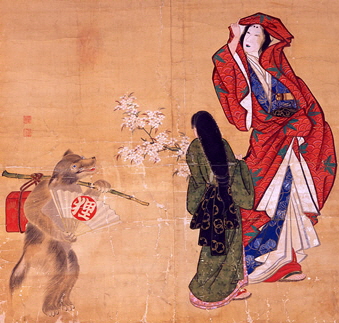
Ōtsu Matsuri, Saigyō-zakura Tanuki-yama 「Bijin Tanuki」. 大津祭、西行桜狸山「美人狸」
Date unknown (mid-19th century perhaps). Treasure of Kajiyachō Saigyō-zakura Tanuki-yama
Conservation Association in Kajiyachō/Kajiyamachi 鍛治屋町西行桜狸山保存会蔵,
Ōtsu City 大津, Shiga Prefecture. Photo from Shigaraki Ceramic Cultural Park (SCCP)
ABOVE. Tanuki arriving from afar (he carries a suitcase) to view the famed cherry blossoms of Ōtsu. The character for Tanuki 狸 is written on the fan he carries. But his visit disturbs the tranquility of two beauties who are already there. If we recall, one of Tanuki’s chief delights is to annoy people. This scroll painting is very clever. FIRST, it clearly references Saigyō Hōshi 西行法師 (1118 – 1190), one of the great masters of tanka poems and a Buddhist monk whose life became the subject of many narratives. Saigyōzakura 西行桜 (lit. = Monk Saigyō's Cherry Tree) is a Noh play by the famed Zeami 世阿弥 (1363-1443), wherein Saigyō decides to remain alone in the garden of his hermitage (not far from Kyoto), where the cherry blossoms are in full bloom. These blossoms are reputed to be the most beautiful anywhere, so eventually travelers from afar come to the hermitage and request permission to view them, thereby disturbing Saigyō's retreat and causing him to write a poem blaming the blossoms for the arrival of the travelers. He eventually lets them in, for he realizes that no matter where he goes, he cannot escape the world of sorrows. The problem is not the “world” but what’s “within you.” SECOND, the painting also clearly references Ōtsu City and the Ōtsu Matsuri Festival. Ōtsu was an oft-visited post town on the Tōkaidō 東海道 road, at the tip of Lake Biwa 琵琶 in Ōmi 近江 province (present-day Shiga prefecture), not far from Kyoto. In April, the cherry blossoms of Ōtsu attract huge crowds from around the country. In the fall, the Ōtsu Matsuri Festival brings similar crowds. THIRD, Tanuki often shape-shift into beautiful women to deceive people. This scroll painting incorporates all three themes. See brief modern analysis of the Noh drama Saigyo Zakura by Sasha Maggio (June 9, 2010).

ABOVE. Flying-Dragon Tanuki 飛龍狸 of Awa Province 阿波国 (present-day Tokushima Prefecture, Shikoku) battles with the Nine-Tailed White Fox 白九尾の狐. From a mid-20th-century Kami Shibai 紙芝居 (Paper Theater Drawing). Photo Tokyo Metropolitan Library. Attributed to a story teller from old Musashi Province (Musashi Jūnin 武蔵住人), an area that today includes parts of Tokyo, Saitama, & Kanagawa. In above drawing, Tanuki wears a red robe. H = 34 cm, W = 49 cm. In the story, the villainous Nine-Tailed White Fox abducts the beautiful maiden Hagino and the Flying-Dragon Tanuki battles for her freedom.
What is Kami Shibai or Gaitō Kami Shibai 街頭 紙芝居? Lit. = “Street-Corner Paper Theater or Curbside Paper Plays. Says this E-site (near bottom of page): “Somewhat related to manga, kami-shibai (紙芝居, lit. ’paper play’ or ’paper theater’) was a street entertainment mainly in the early postwar period. Scenes would be drawn out on separate cards, and a storyteller would show each card as a visual aid while telling the story, serving both as narrator, and delivering all the characters’ lines, in different voices of course. I had never seen kami-shibai before, and actually had a very different impression of it, thinking it was more like shadow puppets, when in fact it’s a bit more like an anime with only one frame per scene.” <end quote> See more examples at Tokyo Metropolitan Library Kami Shibai Collection.
|
DISSECTING A JAPANESE SPOOK-BEAST
Metamorphosis of the Shape-Shifting Tanuki
From Bad Guy to Good Guy, From Feared to Beloved
Tanuki = Modern-Day Icon of Generosity, Cheer, and Prosperity
Tanuki = Lord of Wining, Dining, and Restaurateurs
Tanuki = Wealth-Brining Icon Representing “Luck with Money”
Last Updates

Special thanks to Richard Kagan, Professor Emeritus at Hamline University (Minnesota) for
reviewing this page, suggesting corrections & additions, and providing decades of assistance.
|
|
|
|